The 1958 Ford—An Indirect Casualty Of The Edsel
By Jim and Cheryl Farrell
Most old car enthusiasts like the looks of the 1957 Ford, especially the Fairlane. (In 1957, Ford outsold Chevrolet.) For 1958, the body shell was to be the same, but many suspect the company shot itself in the foot by trying too hard to make the ‘58 Ford look like the ‘58 Thunderbird. But that wasn’t what the car’s designers wanted.
The ‘58 Ford’s design was an indirect result of people problems that arose as a result of the Edsel fiasco. Here’s what happened. In 1955 Lewis Crusoe (then head of Ford Division) and his understudy, Jack Reith, convinced Henry Ford II and Ford executive vice president Ernie Breech that a new car eventually called the Edsel would help Ford catch and surpass GM sooner than what was already planned and approved at Ford. The Edsel was a huge and costly mistake—but supposedly nobody at Ford knew that at the time it was approved. Later in 1955 Crusoe was promoted and became a Ford group vice president in charge of all cars and trucks. At the same time, Robert McNamara got Crusoe’s old job as head of Ford Division. In May 1955 Reith was appointed head of Mercury Division. In October 1956 Crusoe had a heart attack, probably because of flak he was already getting from the not-yet-released Edsel. For months after his heart attack, Crusoe was convalescing, but by late May of the following year, he was forced to retire instead of returning to work. Reith was also forced to retire, after which he either accidentally shot himself or committed suicide. When Crusoe retired, he was again succeeded by McNamara. Jim Wright, who had been in Ford marketing and then became kind of an understudy to Crusoe, was named head of Ford Division. Even before Crusoe was retired, McNamara and Wright were doing the jobs they later inherited because of Crusoe’s incapacity.
Crusoe was a car guy; so was Reith. McNamara and Wright were not; they were finance people who, with Rieth, were “whiz kids.” Crusoe and Reith got most of the blame for the Edsel debacle, but HFII, Breech, and Ford’s board of directors, who approved and implemented the decision to design, build and market the Edsel, mostly escaped any blame.
With that background, we need to take a look at what was happening at the Ford Styling Center. When George Walker took over, he appointed Joe Oros as one of his assistant managers. A year later, Oros was named head of the Ford design studio. Oros, who was previously been one of the designers of the ‘57 Ford Fairlane, wanted to continue the smooth, good looks of the ‘57 Ford Fairlane on the following year’s Ford.
The “big thing” at Ford Division for 1958, was McNamara’s ‘58 4-passenger Thunderbird, which replaced the 2-passenger Thunderbird. According to Oros, Wright insisted that the ‘58 Ford take its design cues from the new, already designed ‘58 Thunderbird. Oros thought that was a mistake, but acknowledged the decision was not his to make. (The fact there was no pushback from Walker or anyone else suggests that McNamara concurred in or was behind Wright’s decision.) Ford Archival photos show the progression of the ‘58 Ford, and how designers were initially searching for a way to keep the good looks of the ‘57 Ford while mildly updating it for 1958. In later photos, the effects of Wright’s decision to make the ‘58 Ford kind of a clone of the Thunderbird can be readily seen. Most of the changes, including the grille, side trim and hood ornament mimic the ‘58 Thunderbird. However, the most noticeable Thunderbird design element on the ‘58 Ford is its two pod, four taillight back end, which was designed by Ford studio designer Al Mueller.
The Ford didn’t sell as well ‘58 as it did in 1957, and most car buyers felt the ‘58 Ford was not as attractive as the ‘57. Even so, Wright’s kept on trying to micromanage the design of Fords. The ‘59 Ford was mostly due to Oros‘ influence, but for 1960, Oros wanted to continue Ford’s big, round taillights. Wright said “no,” so Oros was only able to design into the back bumper a half circle indentation below the taillights that mimicked the round signature Ford taillights. By 1961, Oros’ big round taillights were featured again on both the ‘61 Ford and the ‘61 Thunderbird.
What happened to the executives responsible for the ‘58 Ford? McNamara became president of Ford in November 1960, but in early January 1961, he left to become President Kennedy’s secretary of defense. McNamara’s support of the Vietnam war badly tarnished his reputation. Wright left Ford in May 1963, after he was passed over for Ford president. Crusoe was responsible for many of Ford’s successes of the early 1950s, but he was also the one who got rid of both Benson and Bill Ford on the road to the Edsel. After his forced retirement, he was bitter. Crusoe sold all of his Ford vehicles and remained embittered towards Ford until his death in November 1973.
Photos: Ford Design
Footnote: Notice in the backgrounds of several photos there are renderings of what must have believed to be how the ’58 Chevrolet was going to look. I wonder where they got their information.
V=SxO once again proven to be true. (Validity=Salary times Opinion)—Gary
Books by Jim and Cheryl Farrell
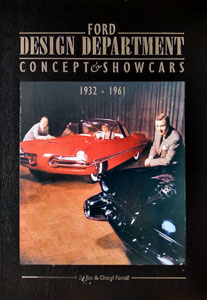
Ford Design Department—
Concepts & Showcars
1999, 10×13, 400 pages, Fully indexed
900 photos. Includes 150+ designers and sculptors, and highlights 100 concept cars.
ISBN 0-9672428-0-0
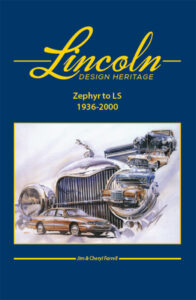
Lincoln Design Heritage:
Zephyr to LS (1936-2000)
2021, 10×13, 480 Pages, Fully Indexed
1,600 photos and illustrations
ISBN 978-0-9672428-1-1
The Ford book is $50 plus $7 S&H (US). The Lincoln book is $85 plus $10 S&H (US). Both books bought together are $110 plus $17 S&H (US). To order, email: cfarrell57@gmail.com

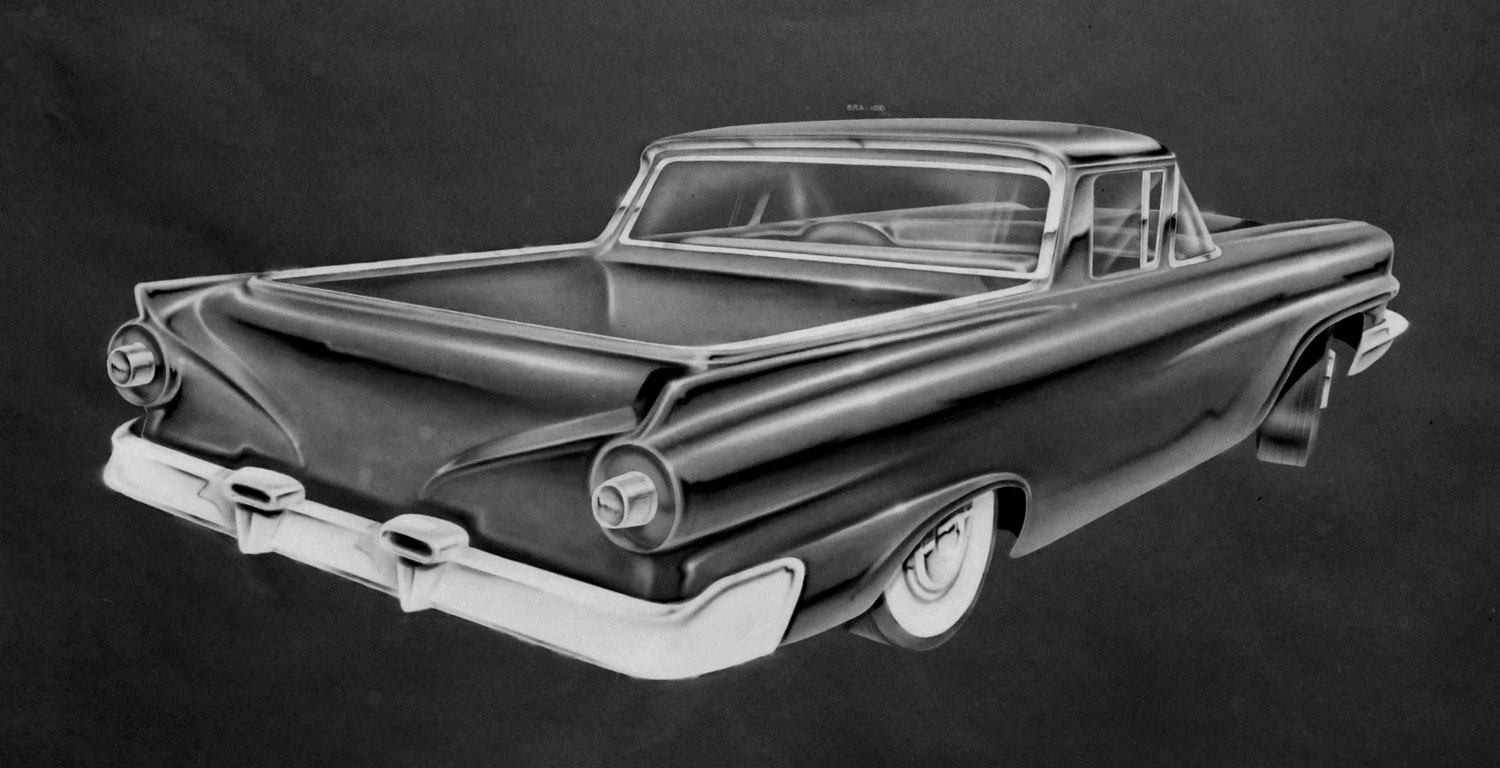
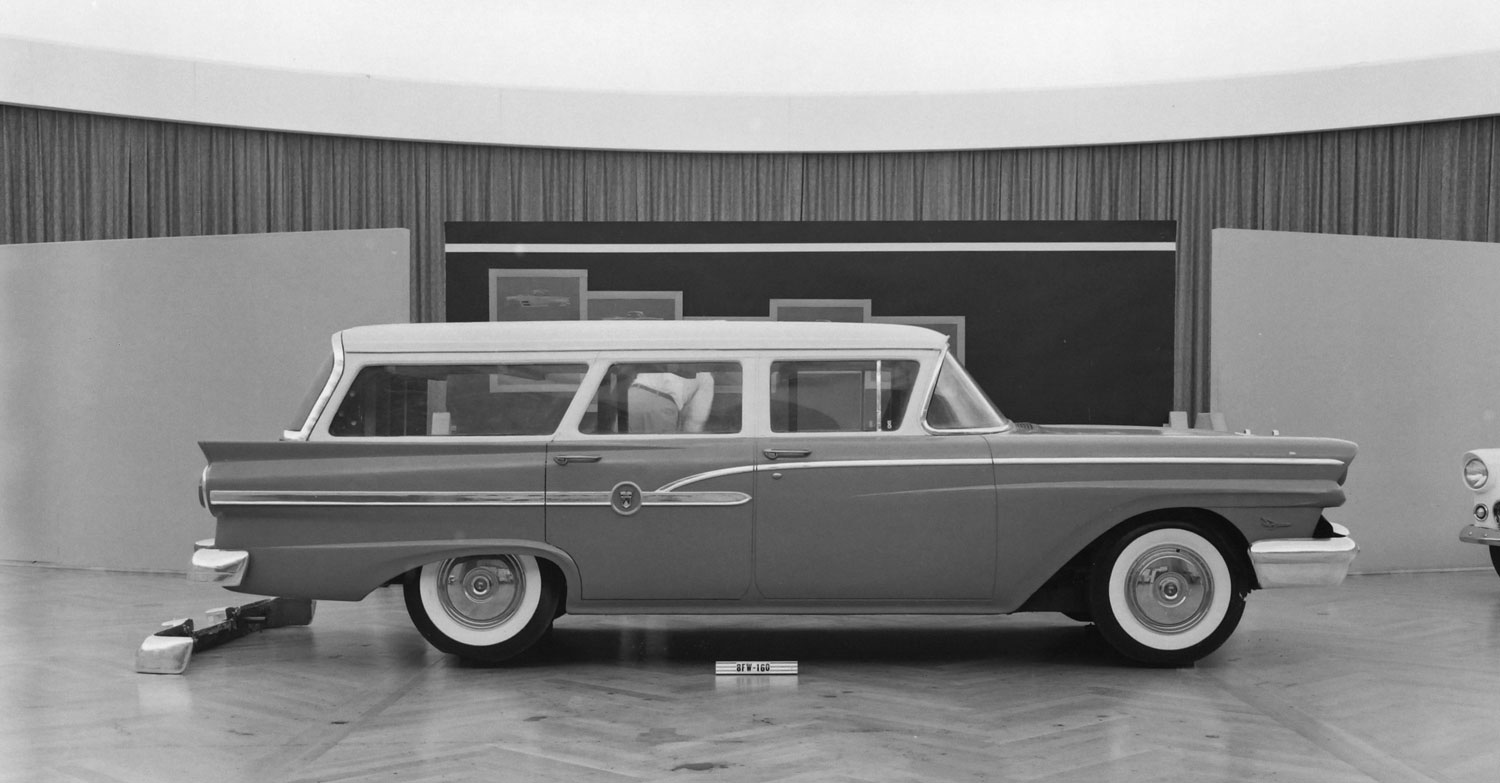
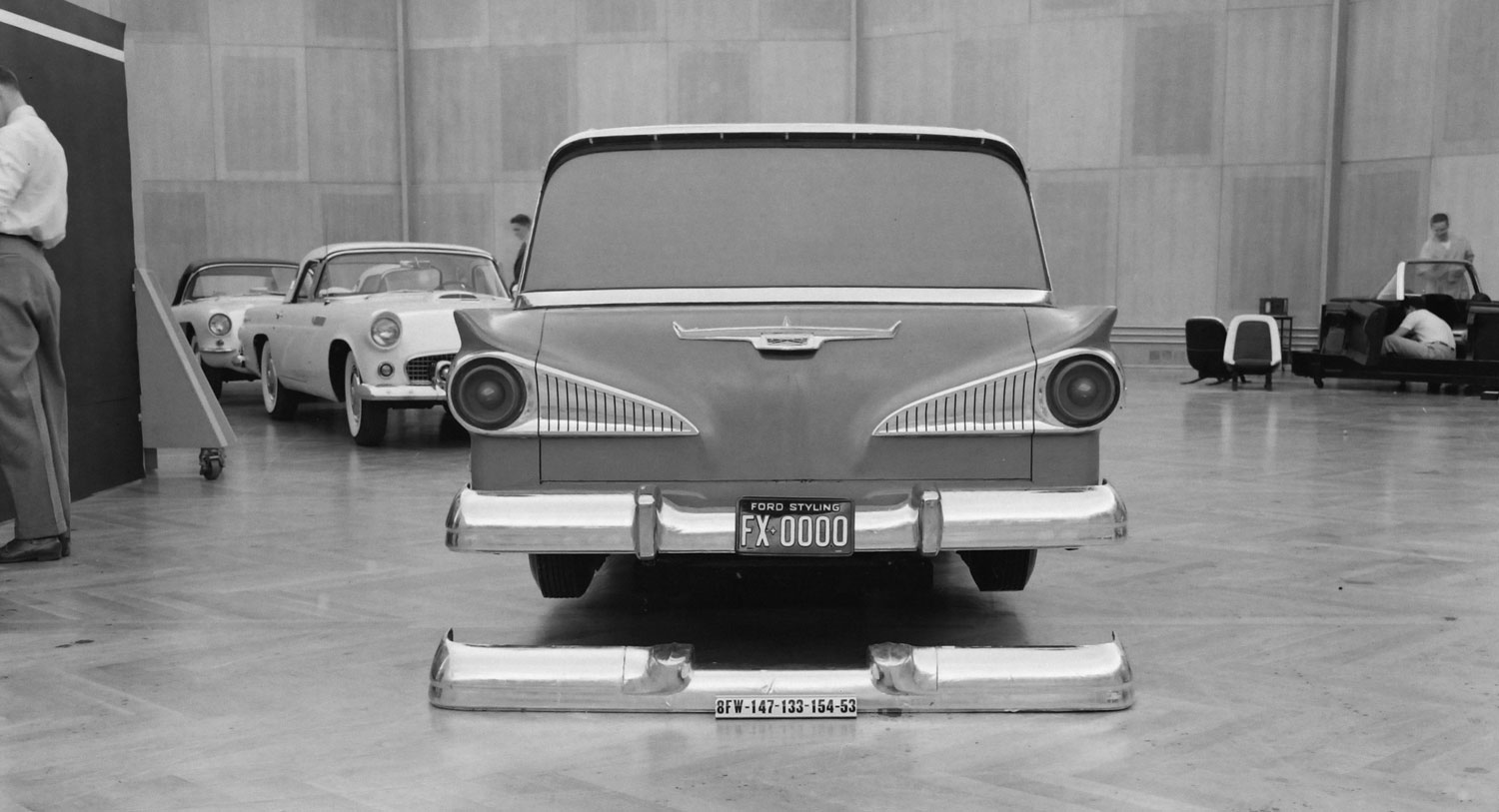
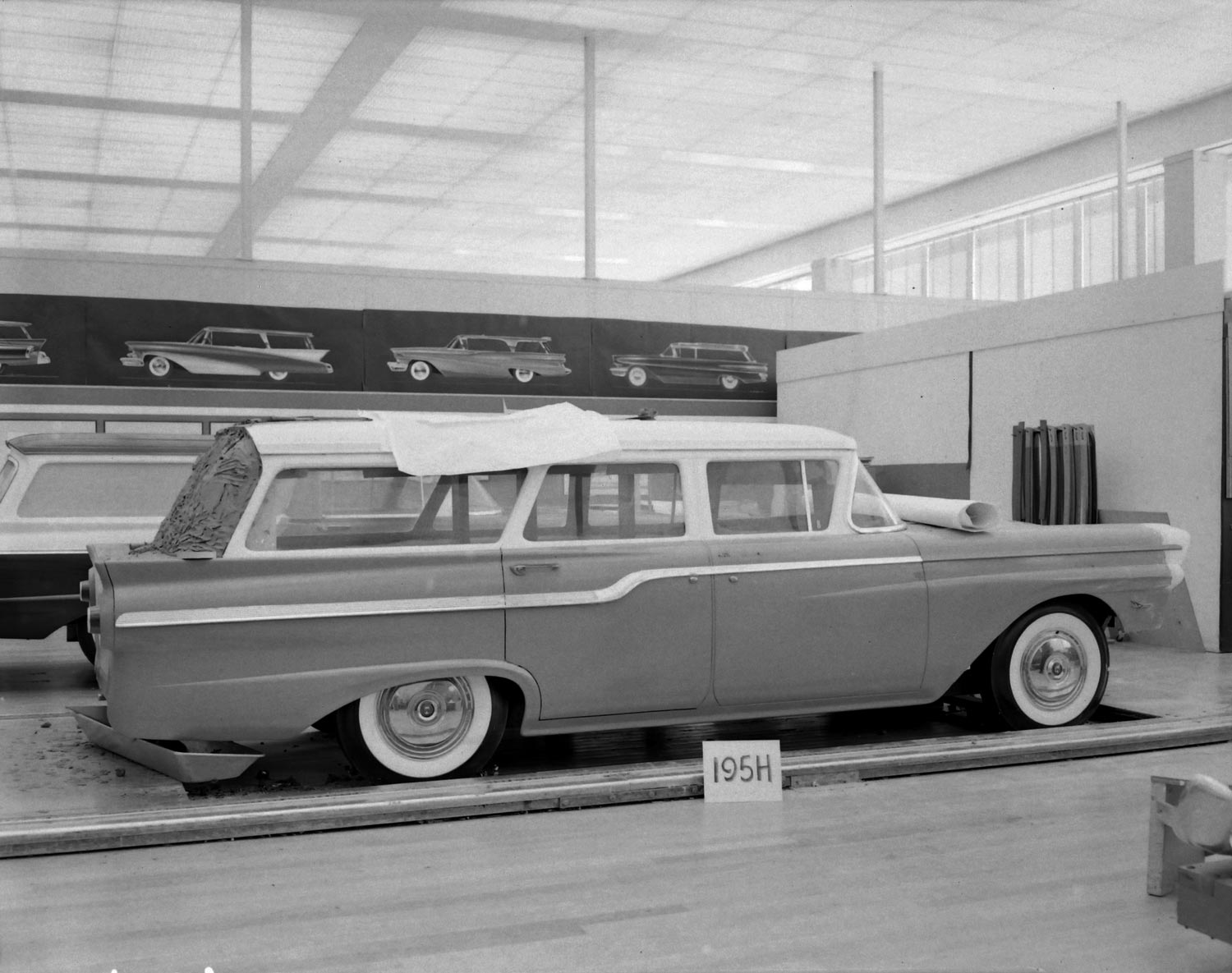
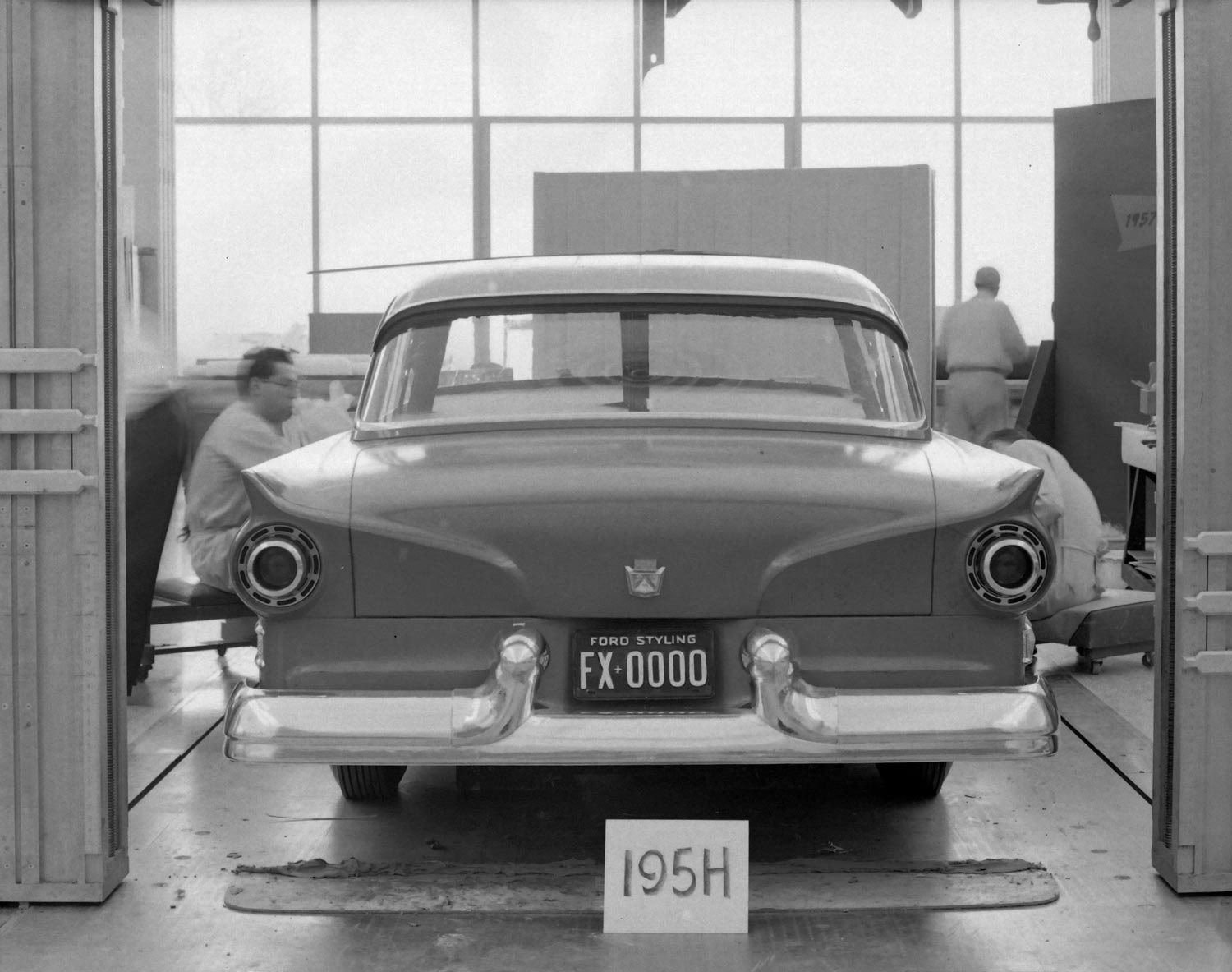
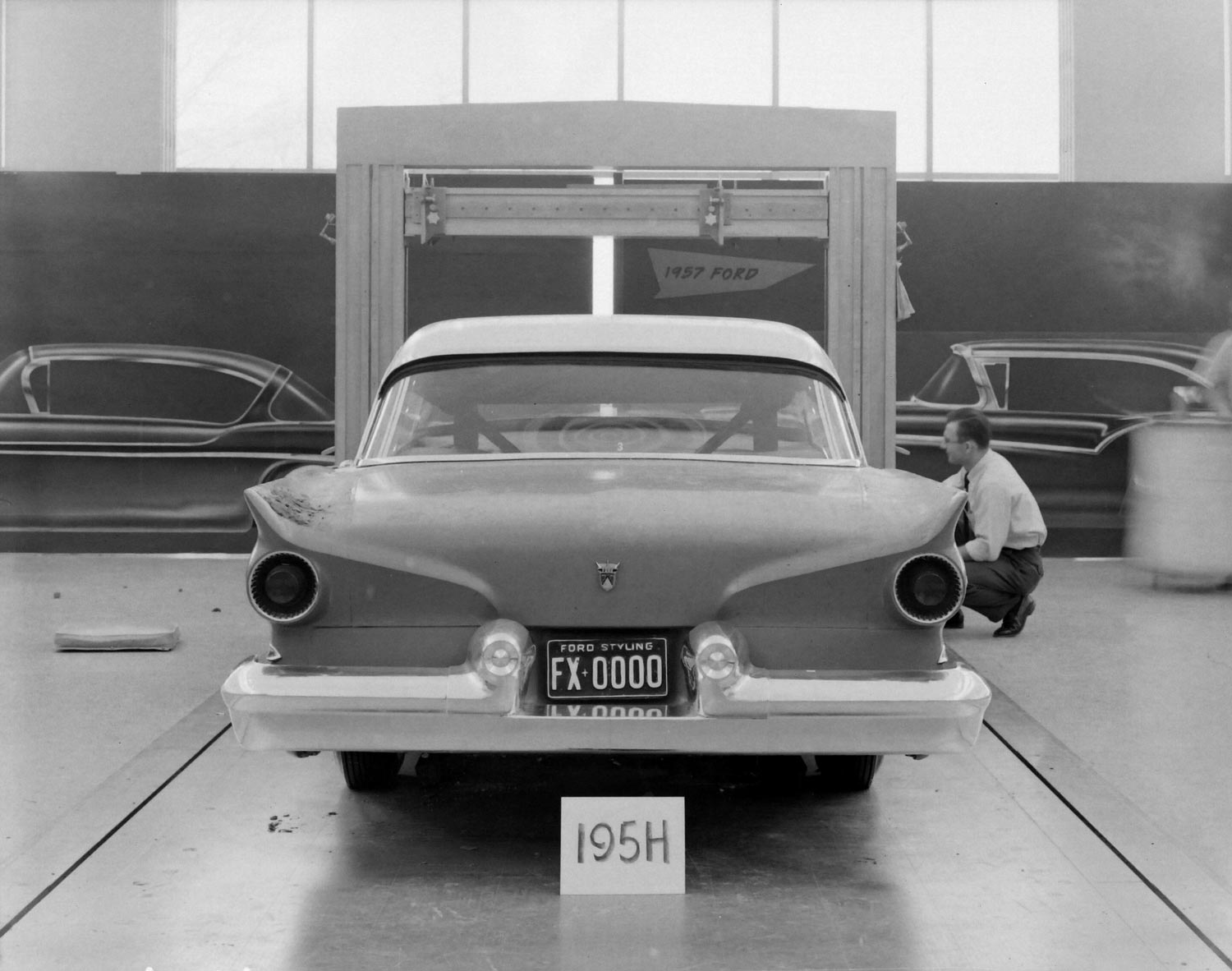
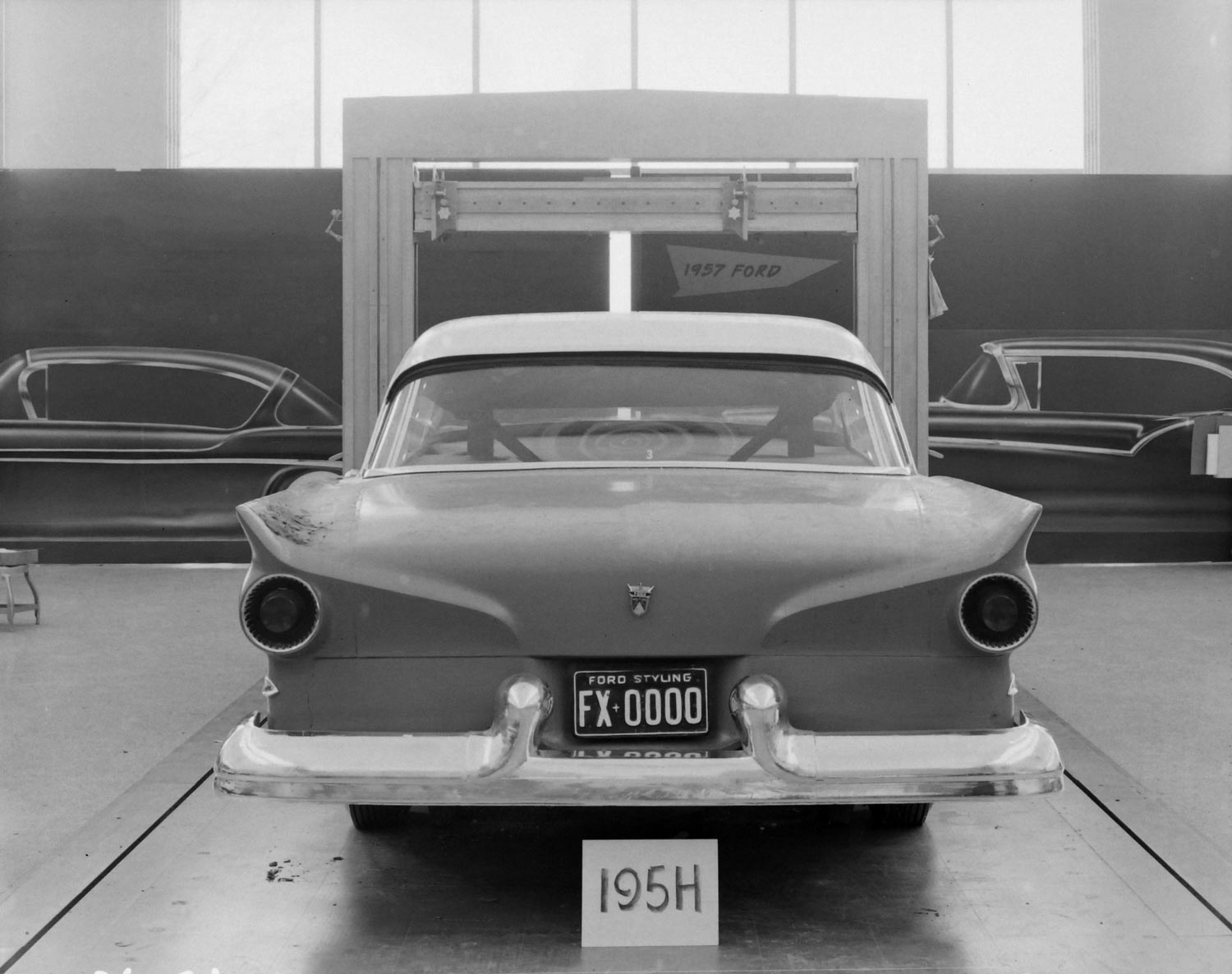
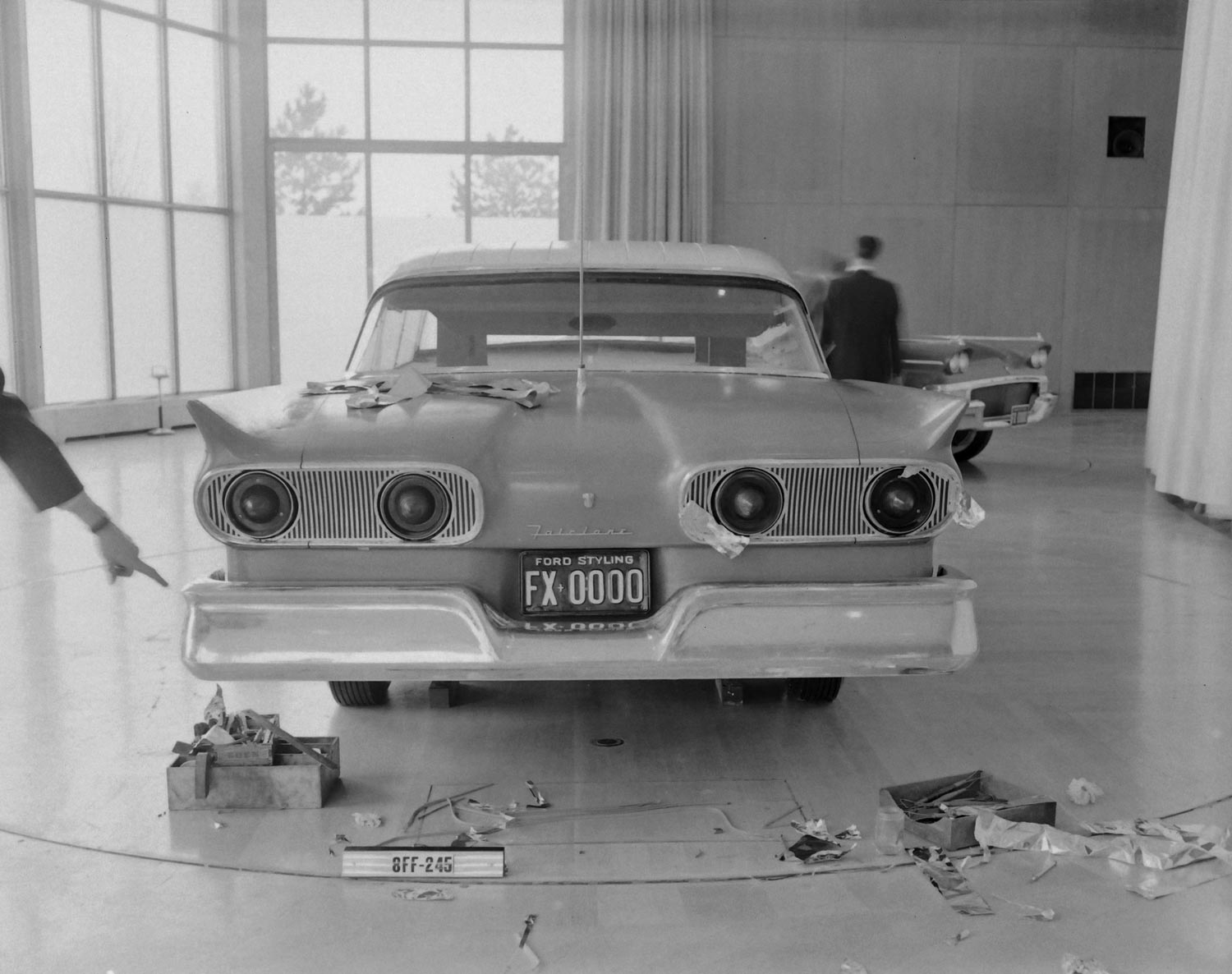
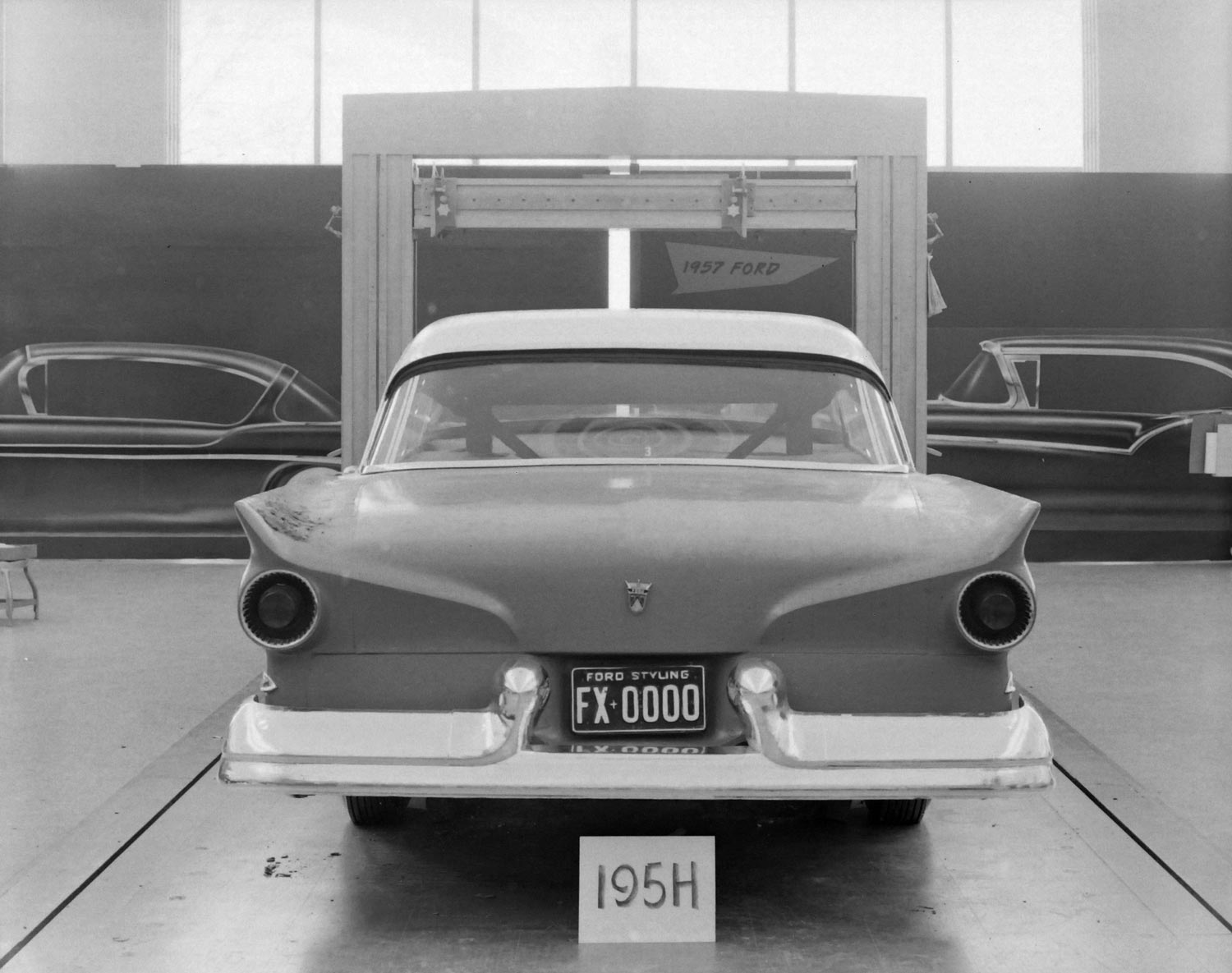
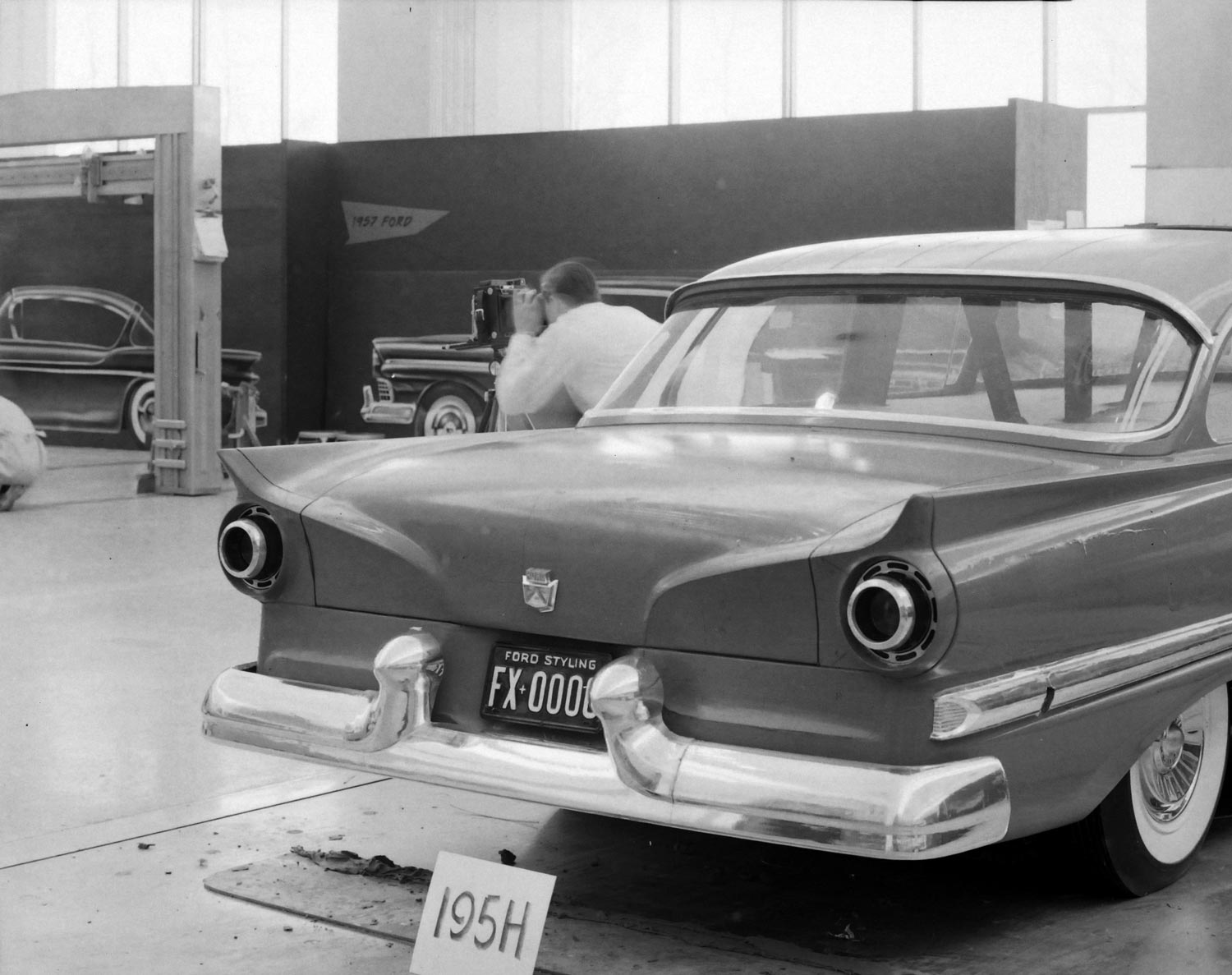
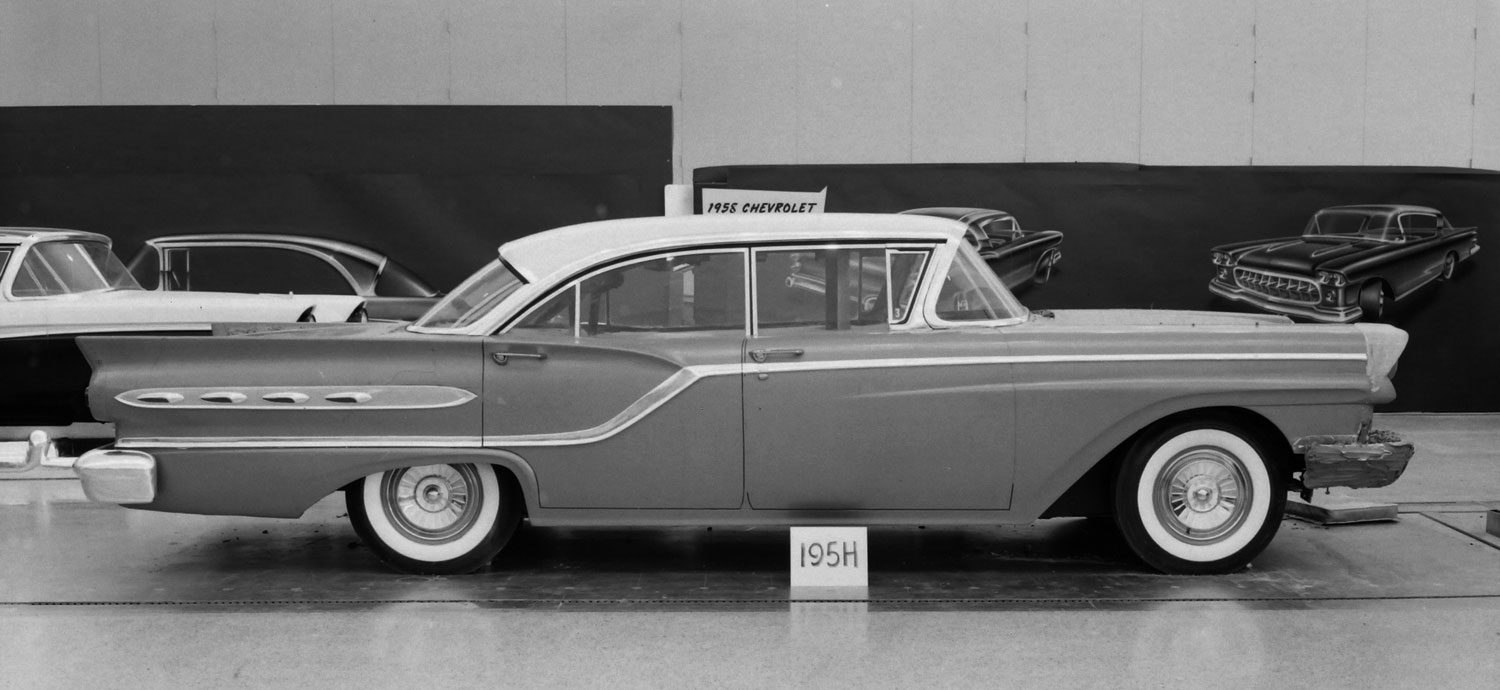
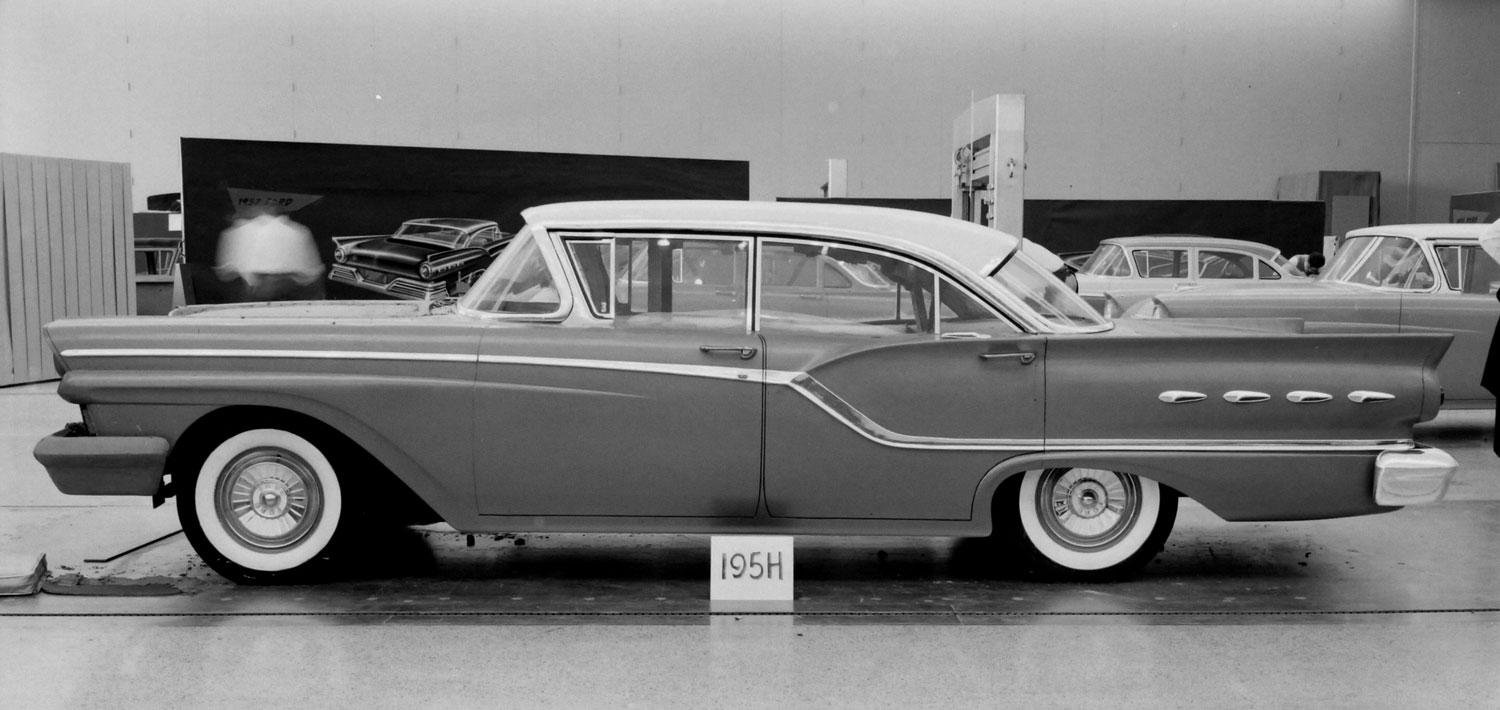
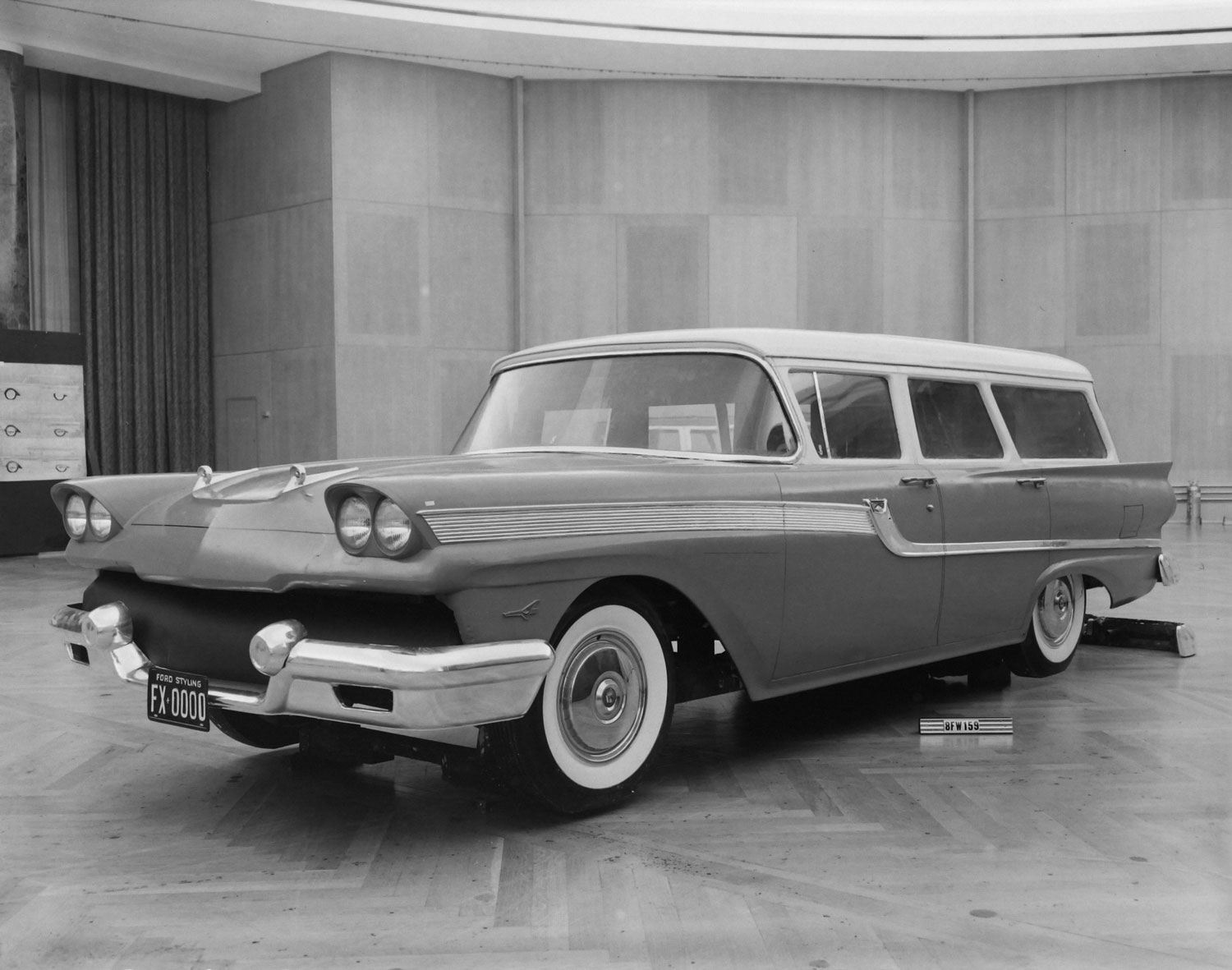
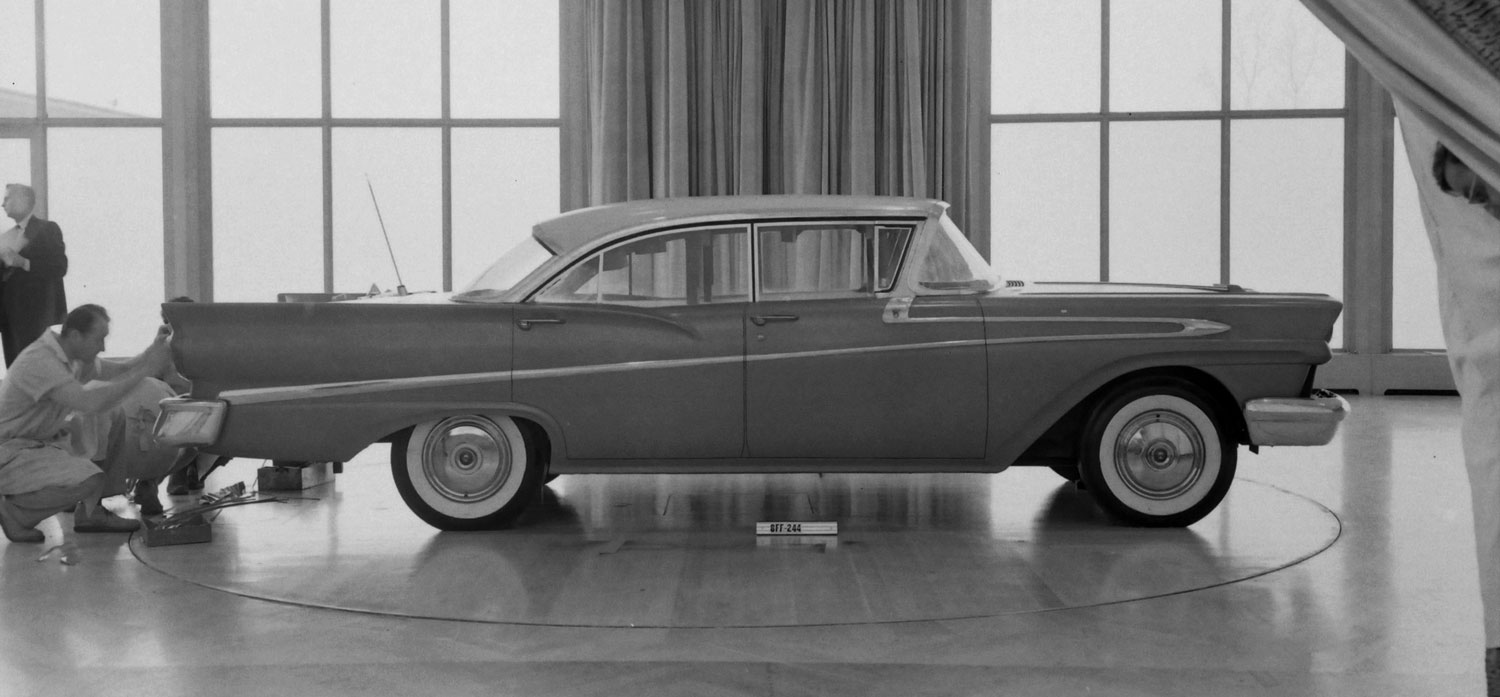
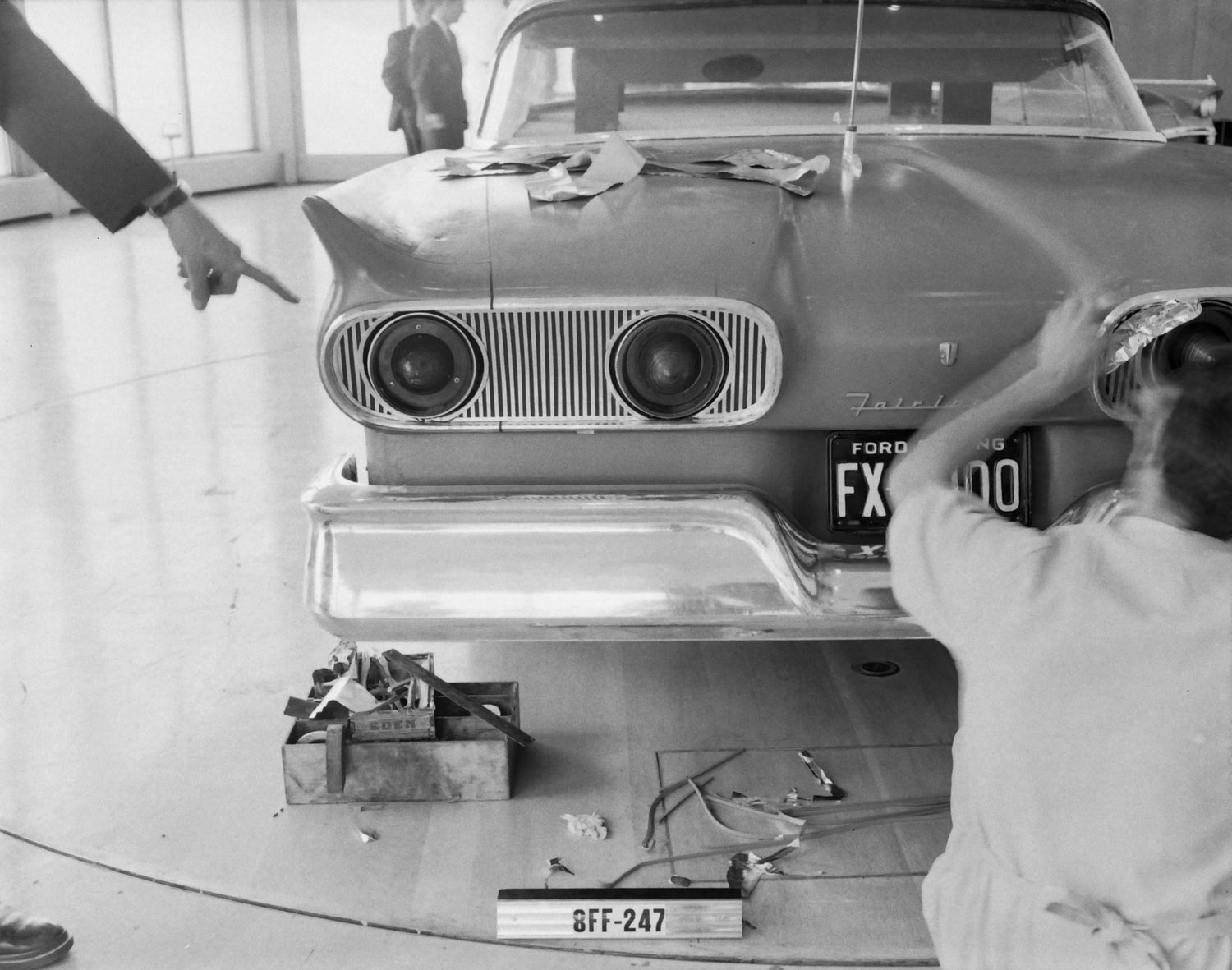
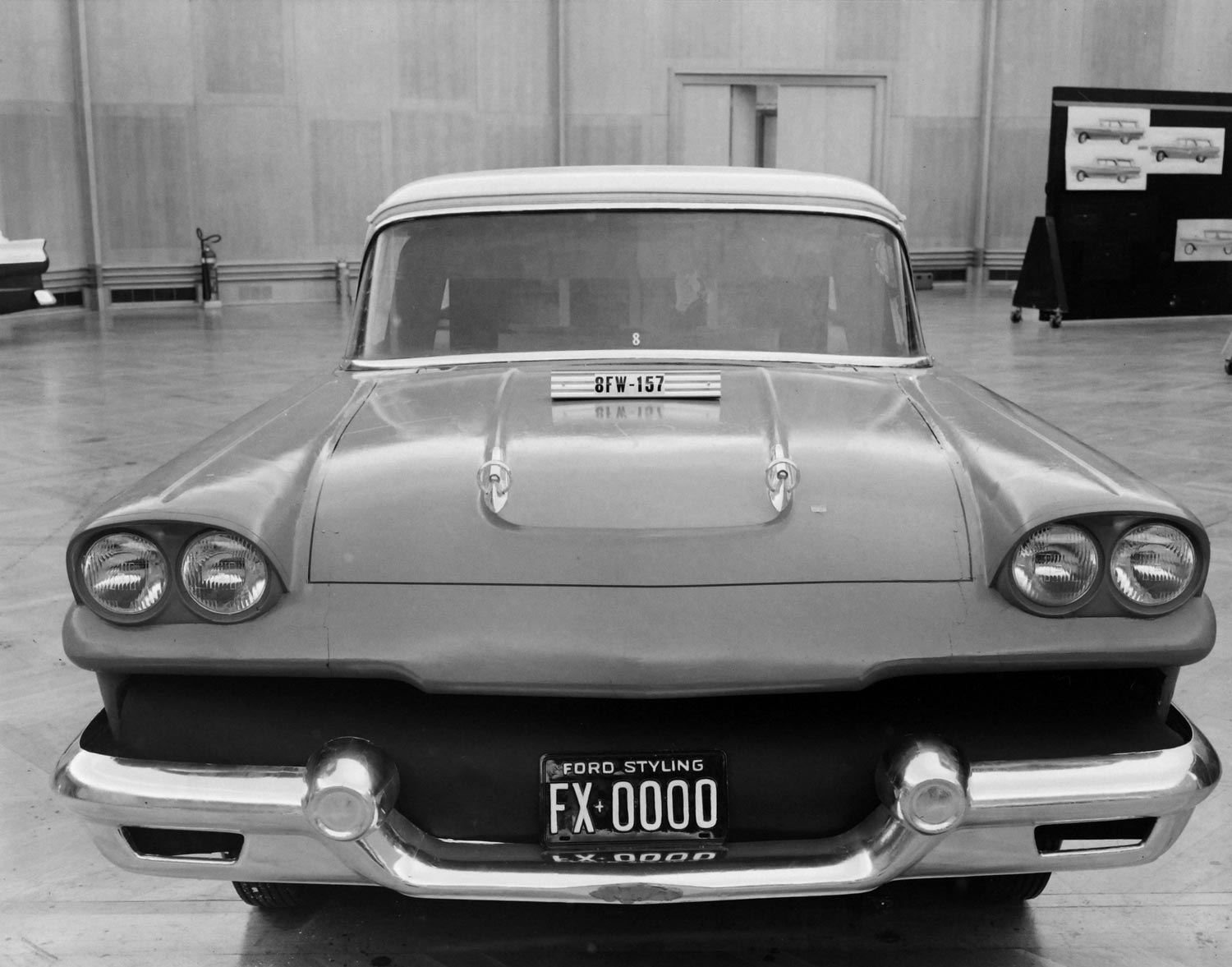
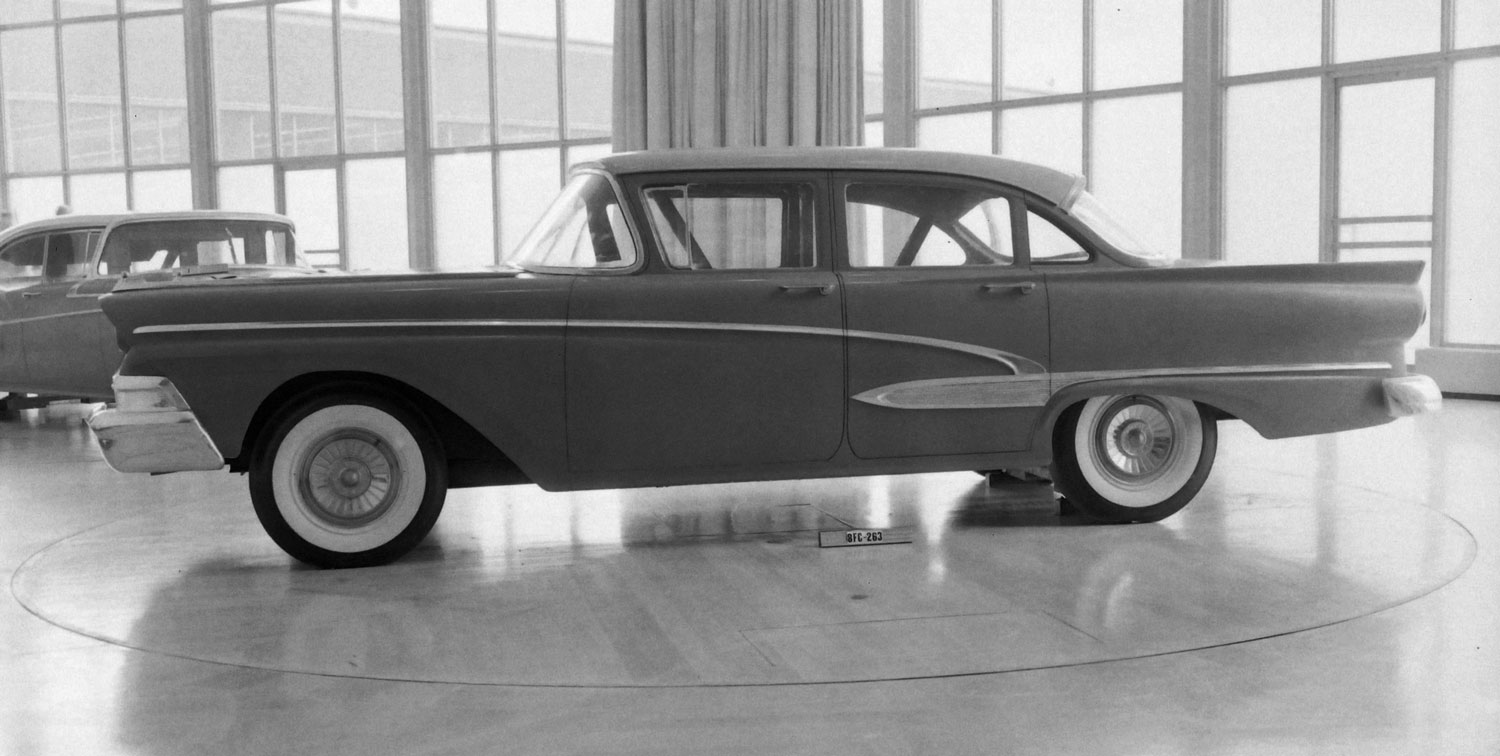
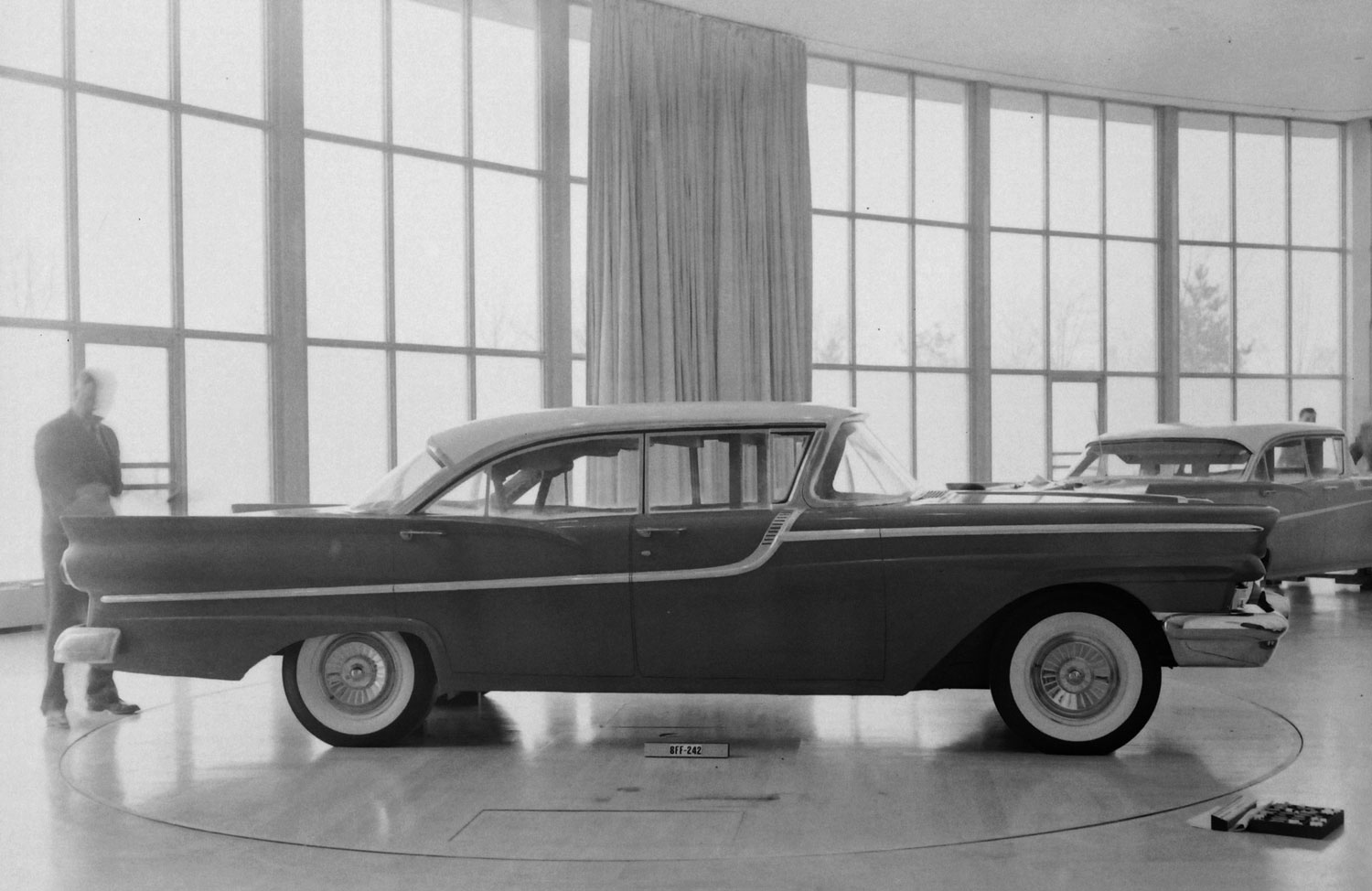
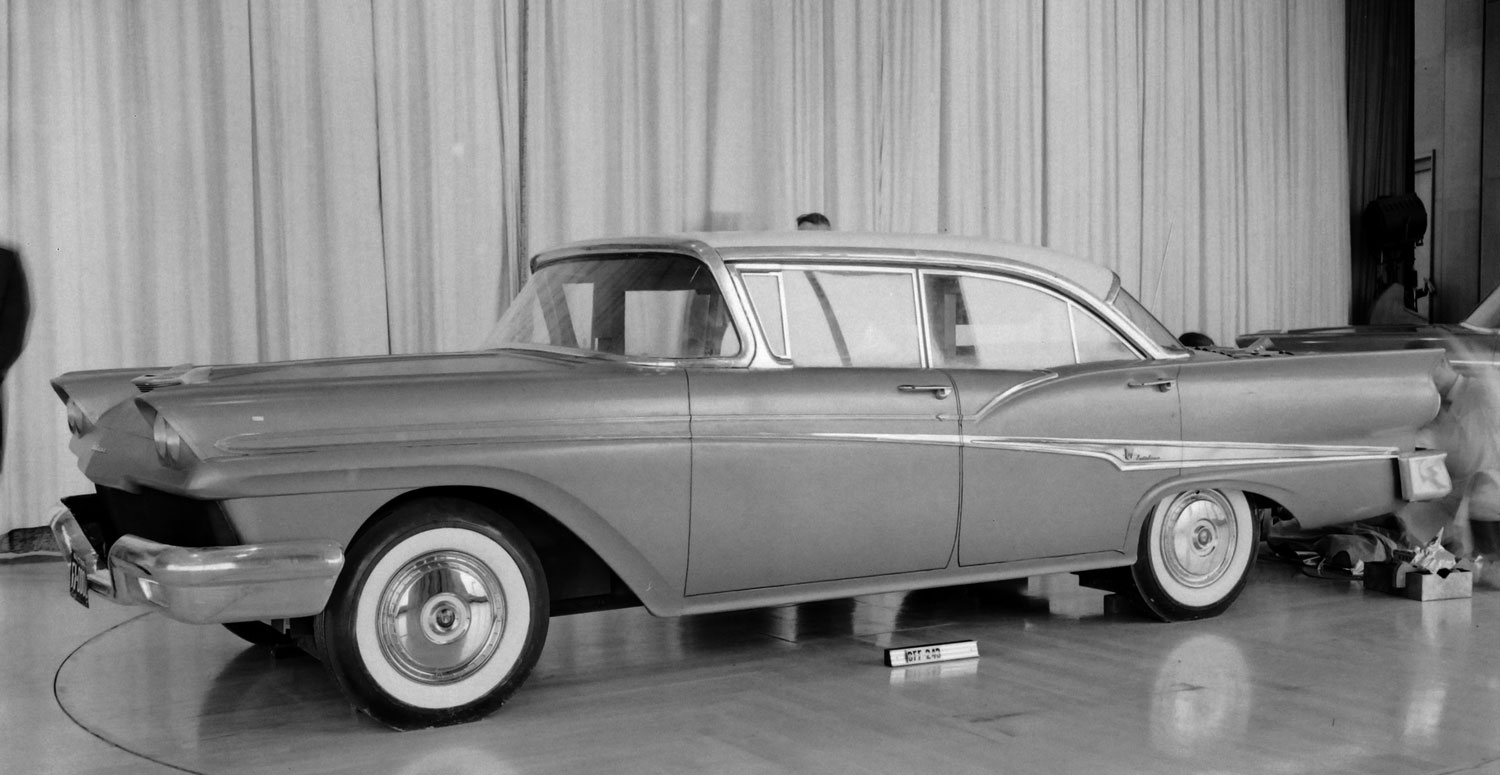
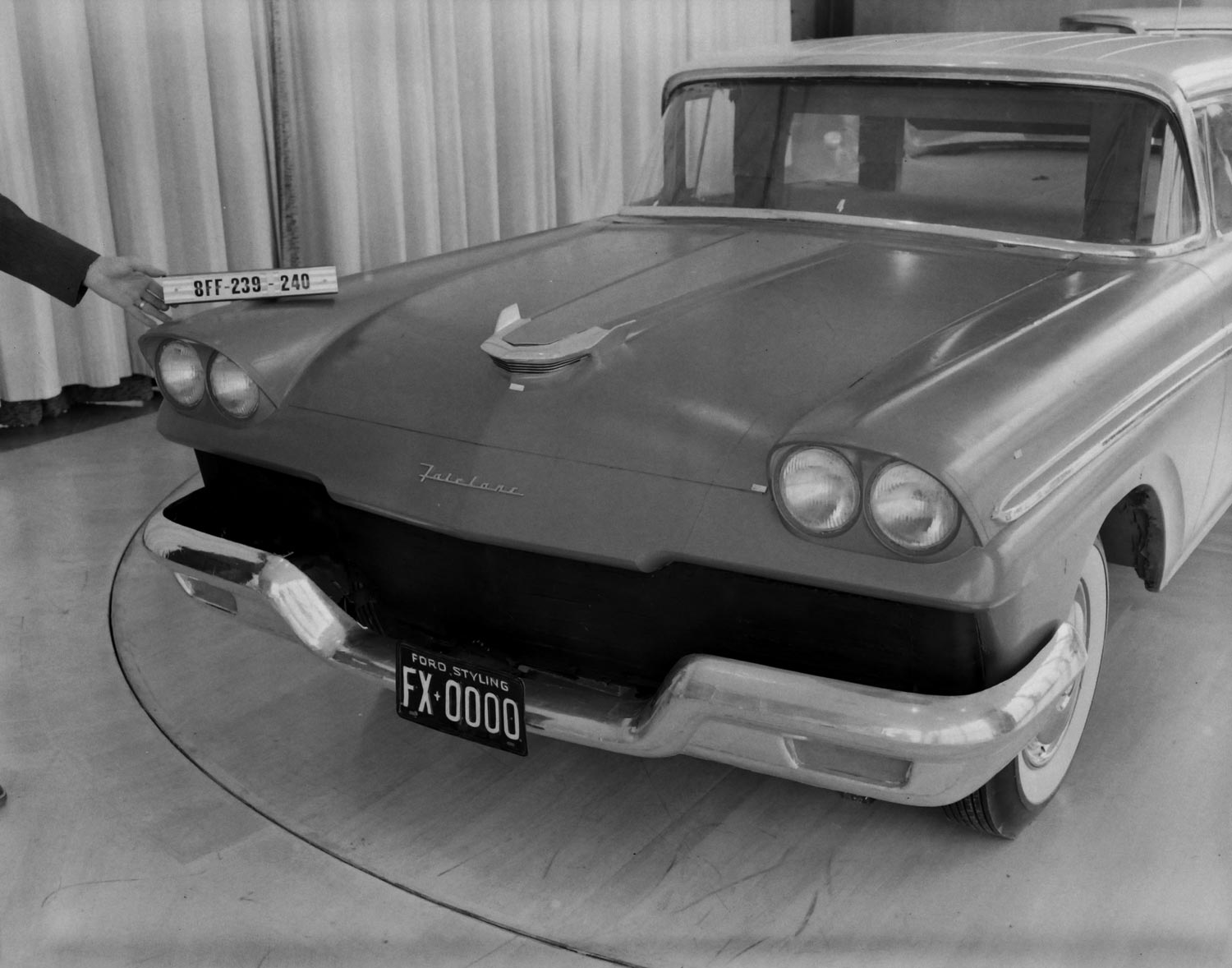
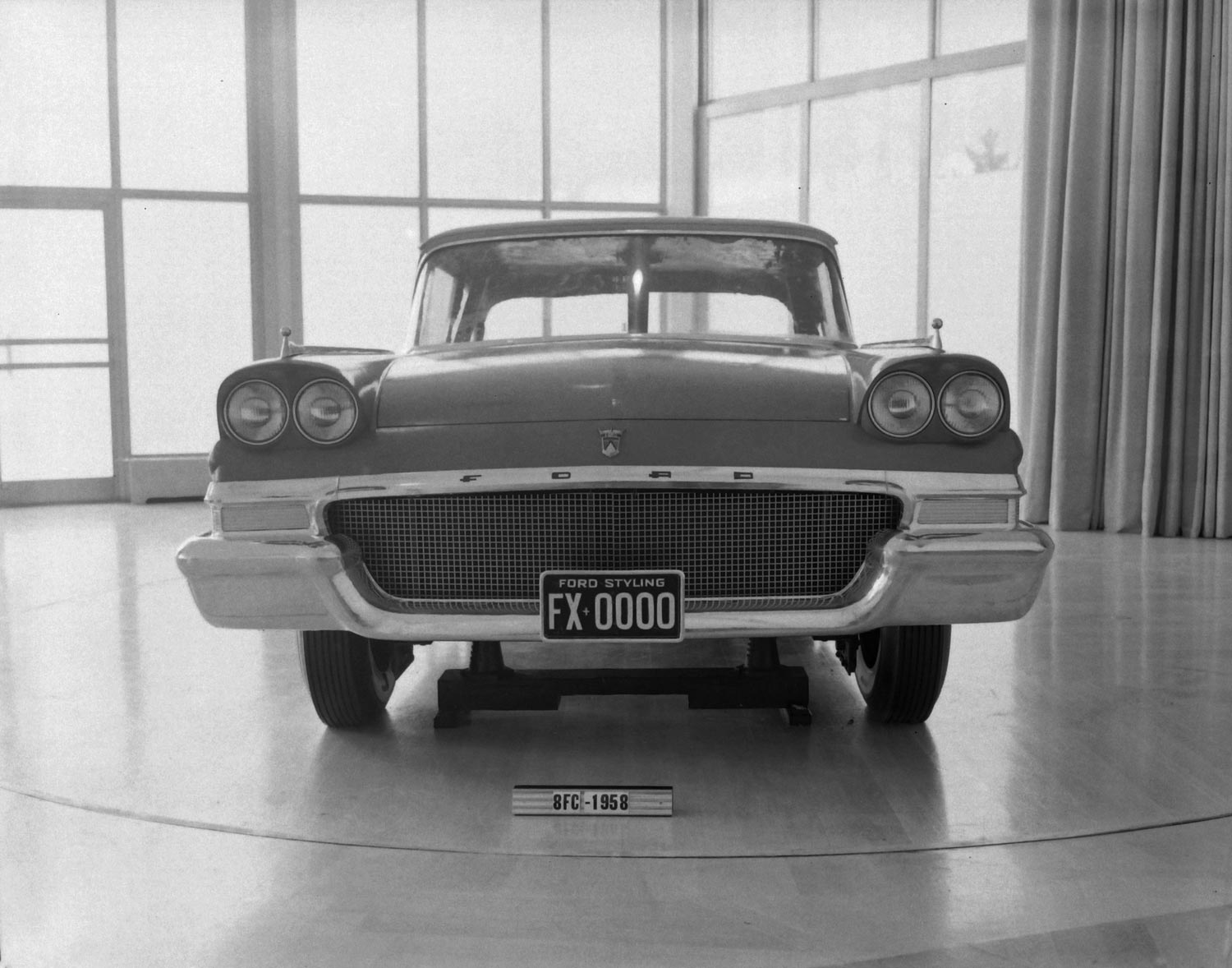
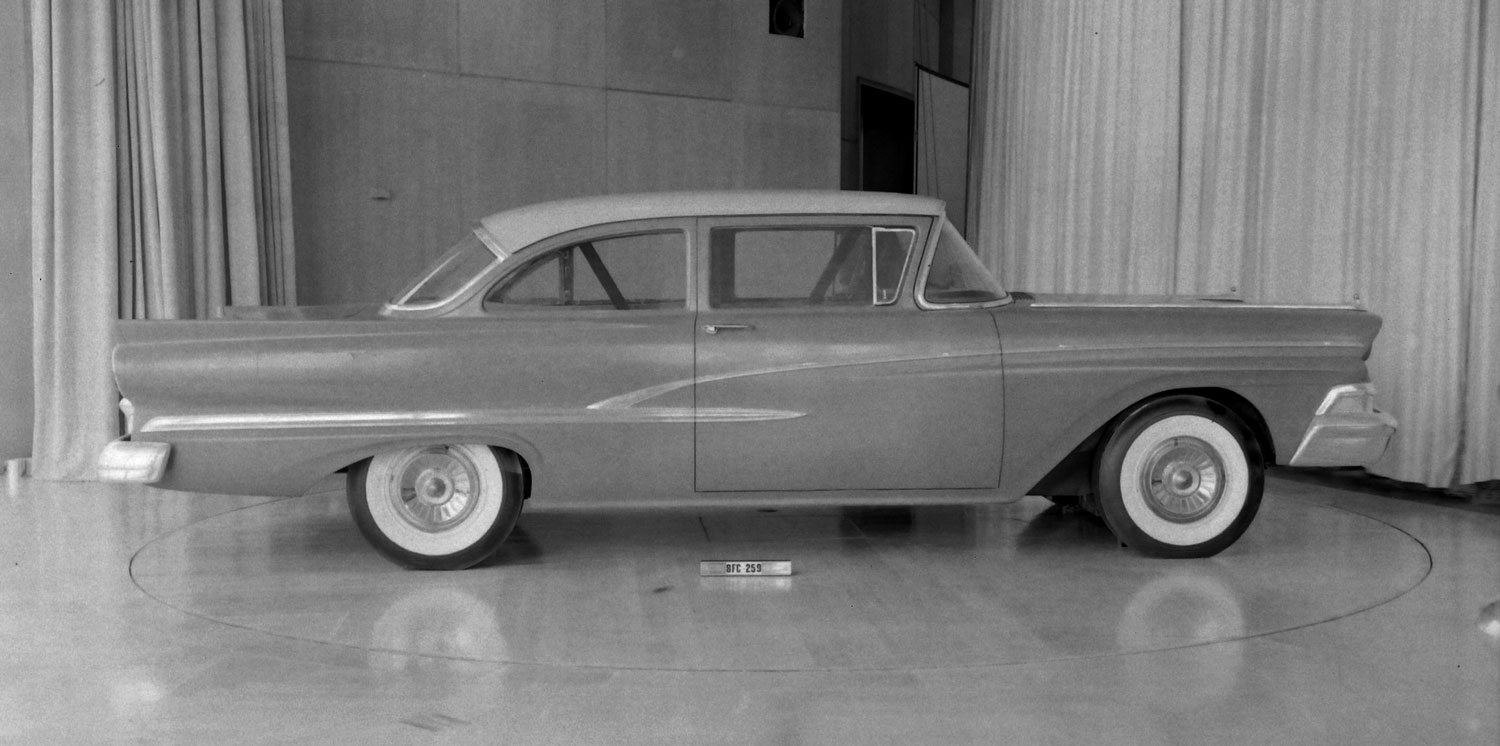
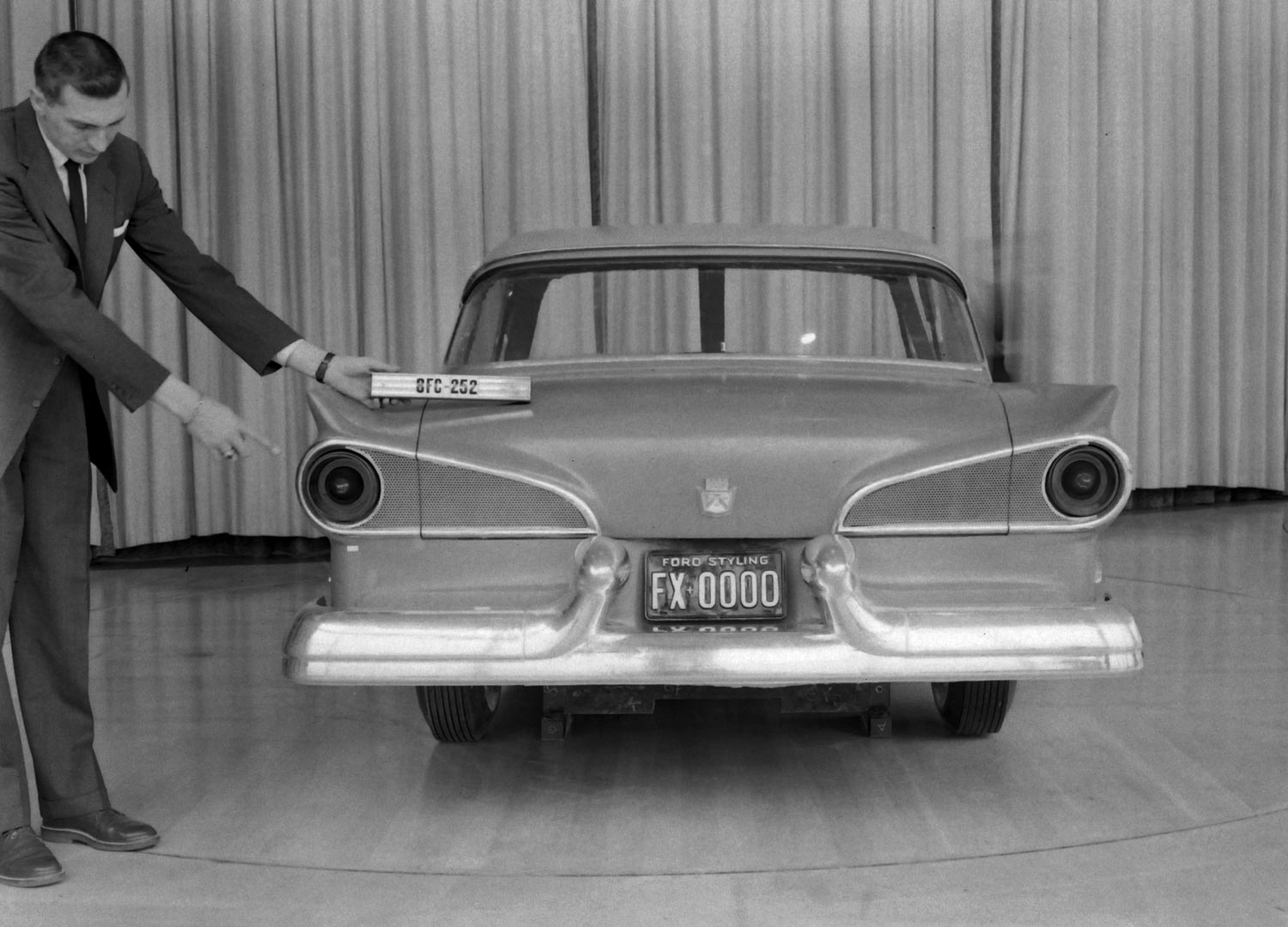
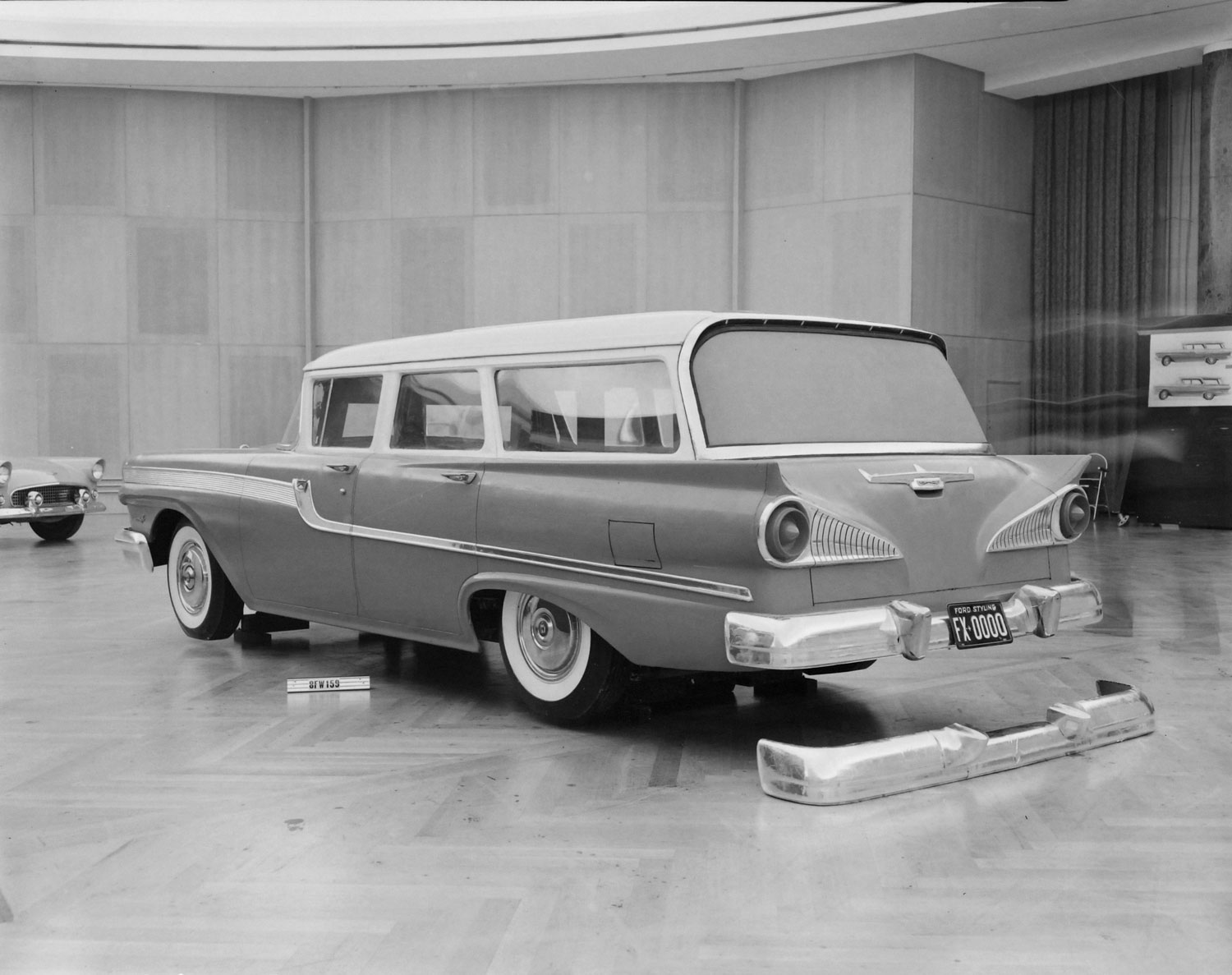
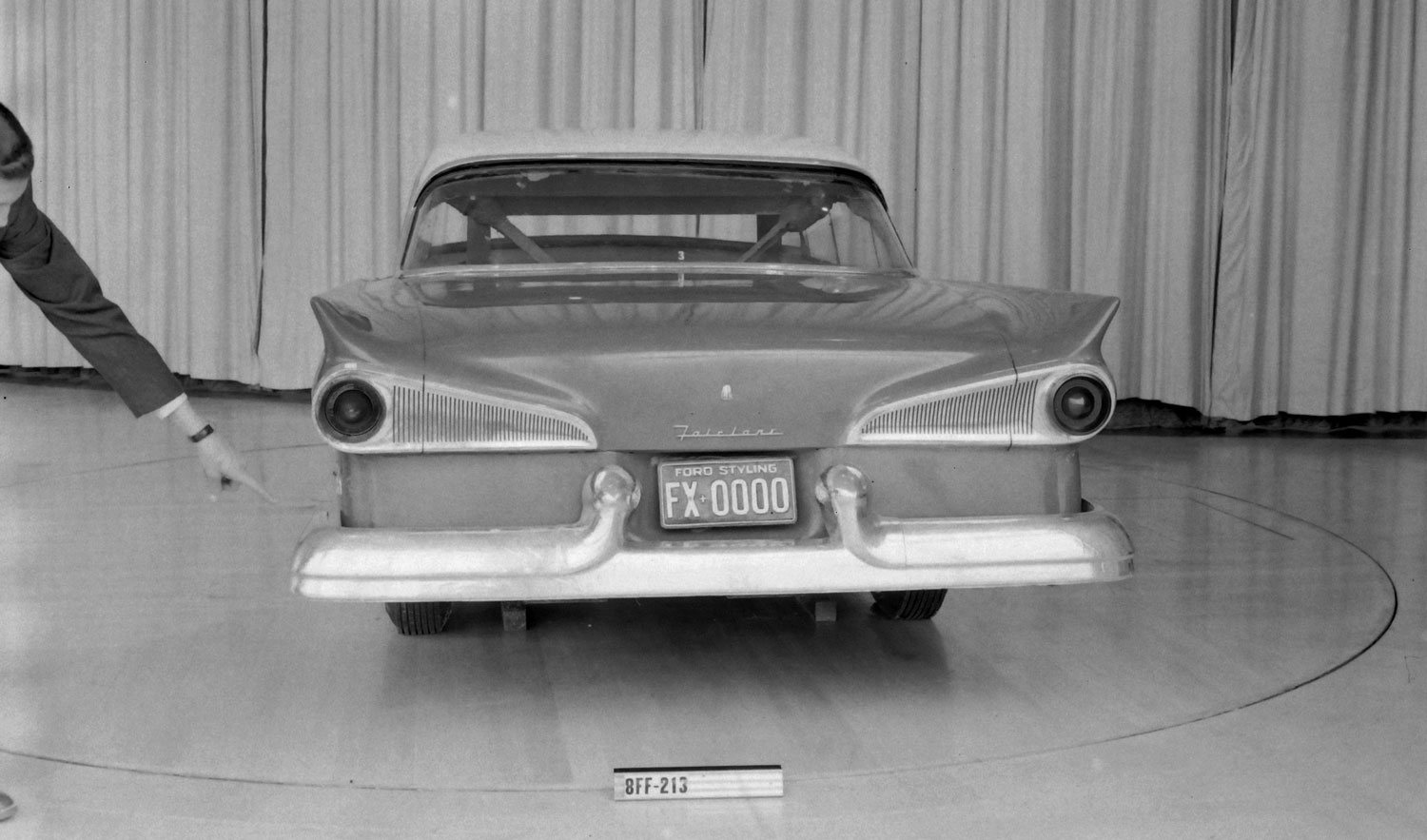
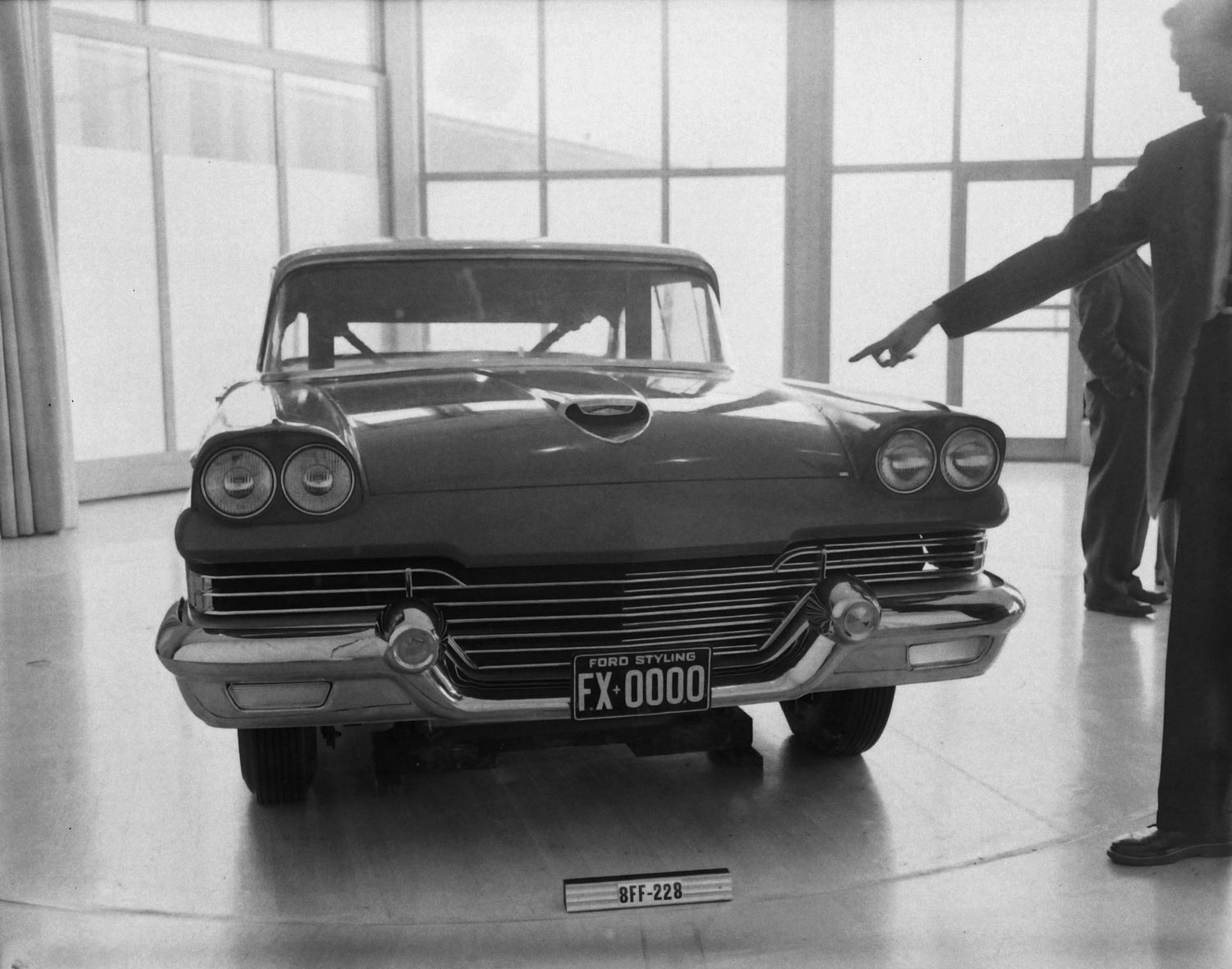
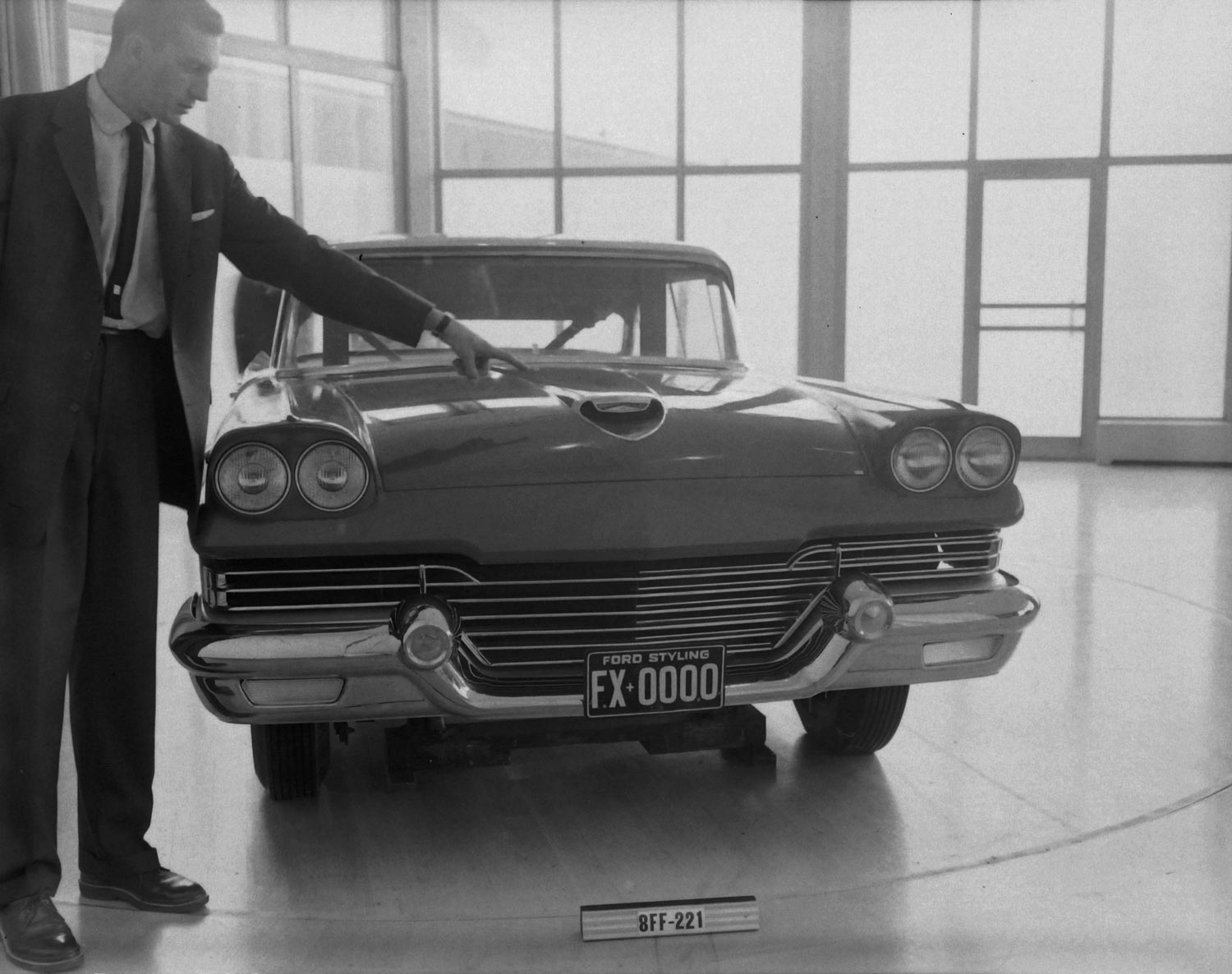
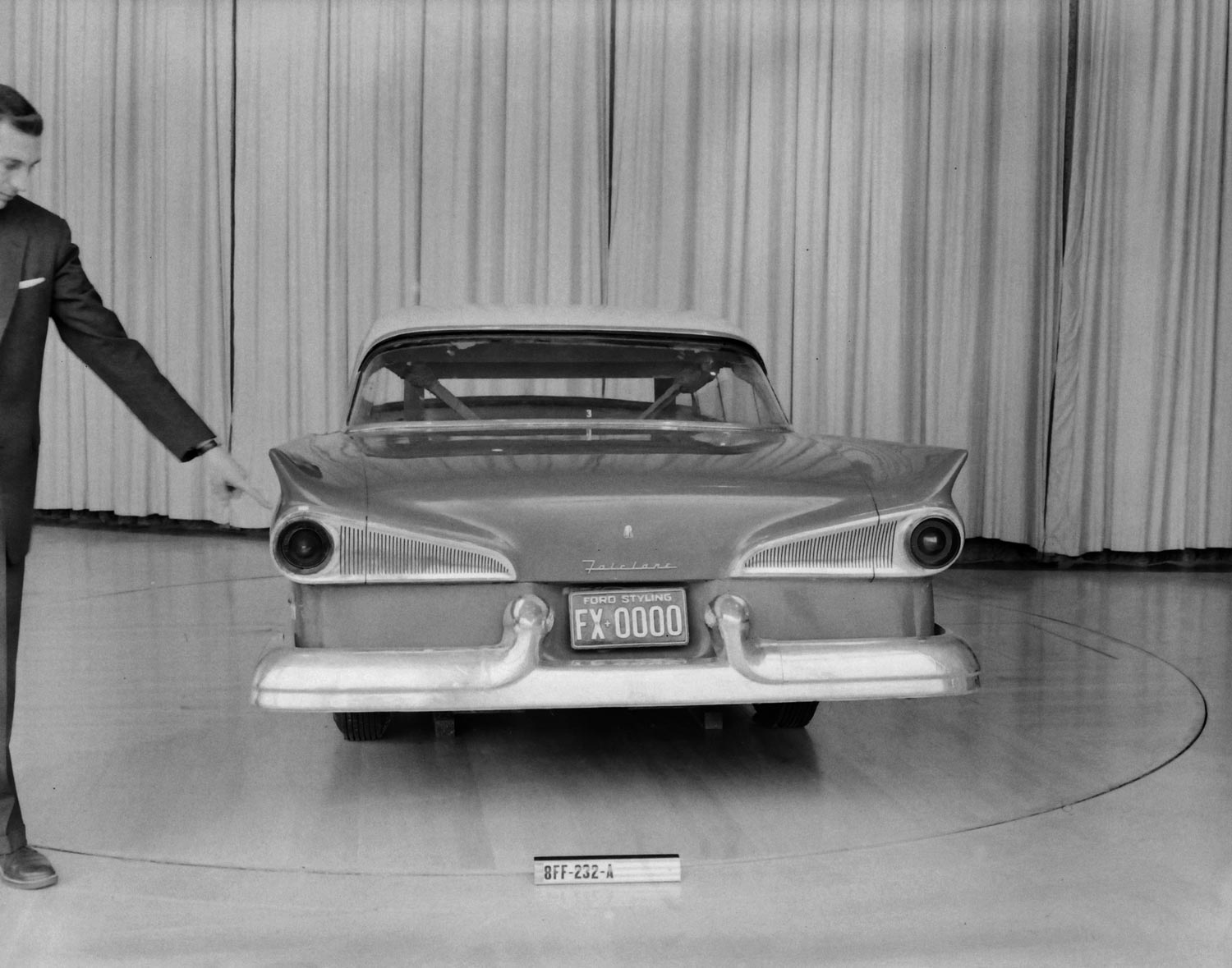
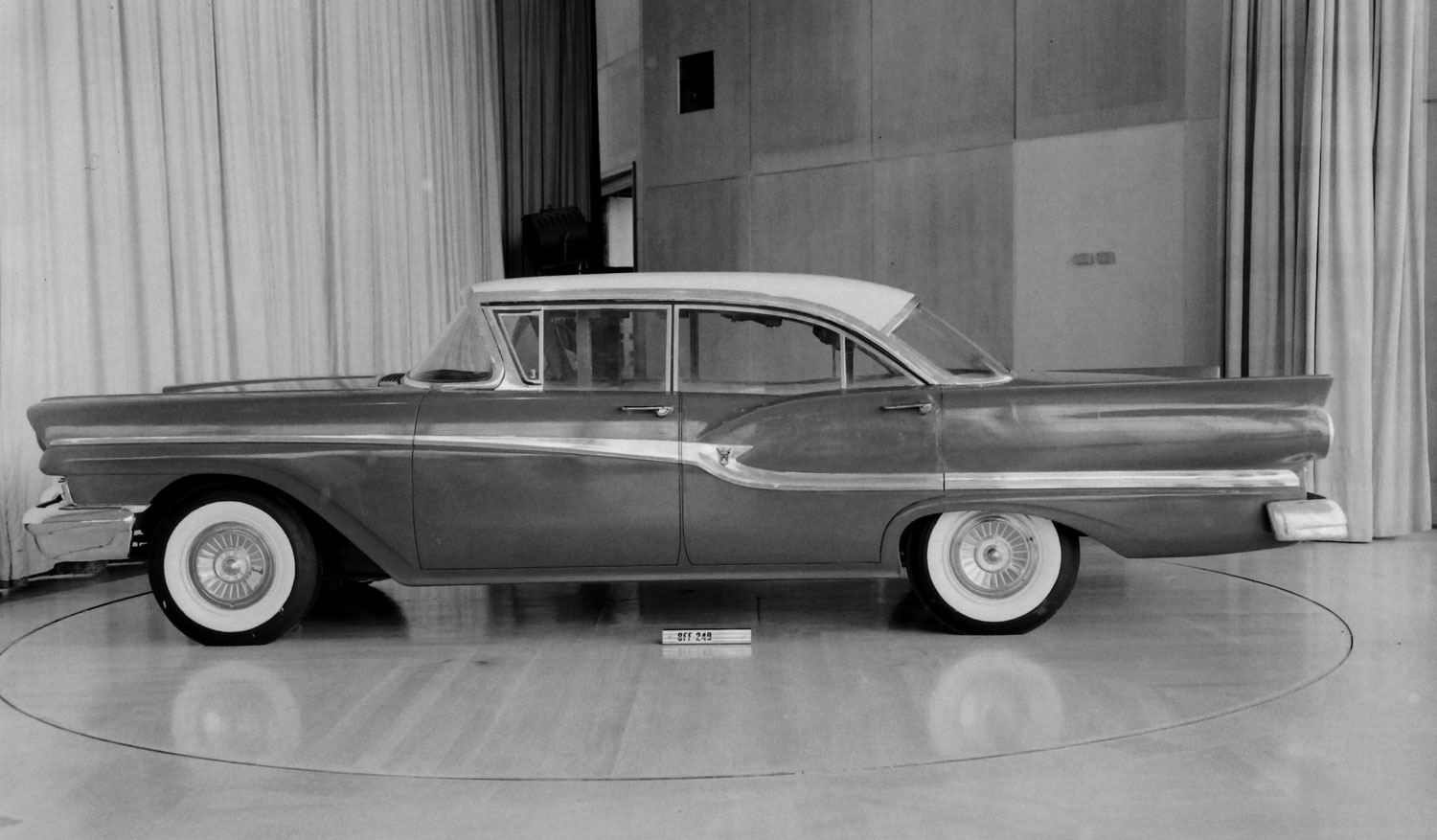
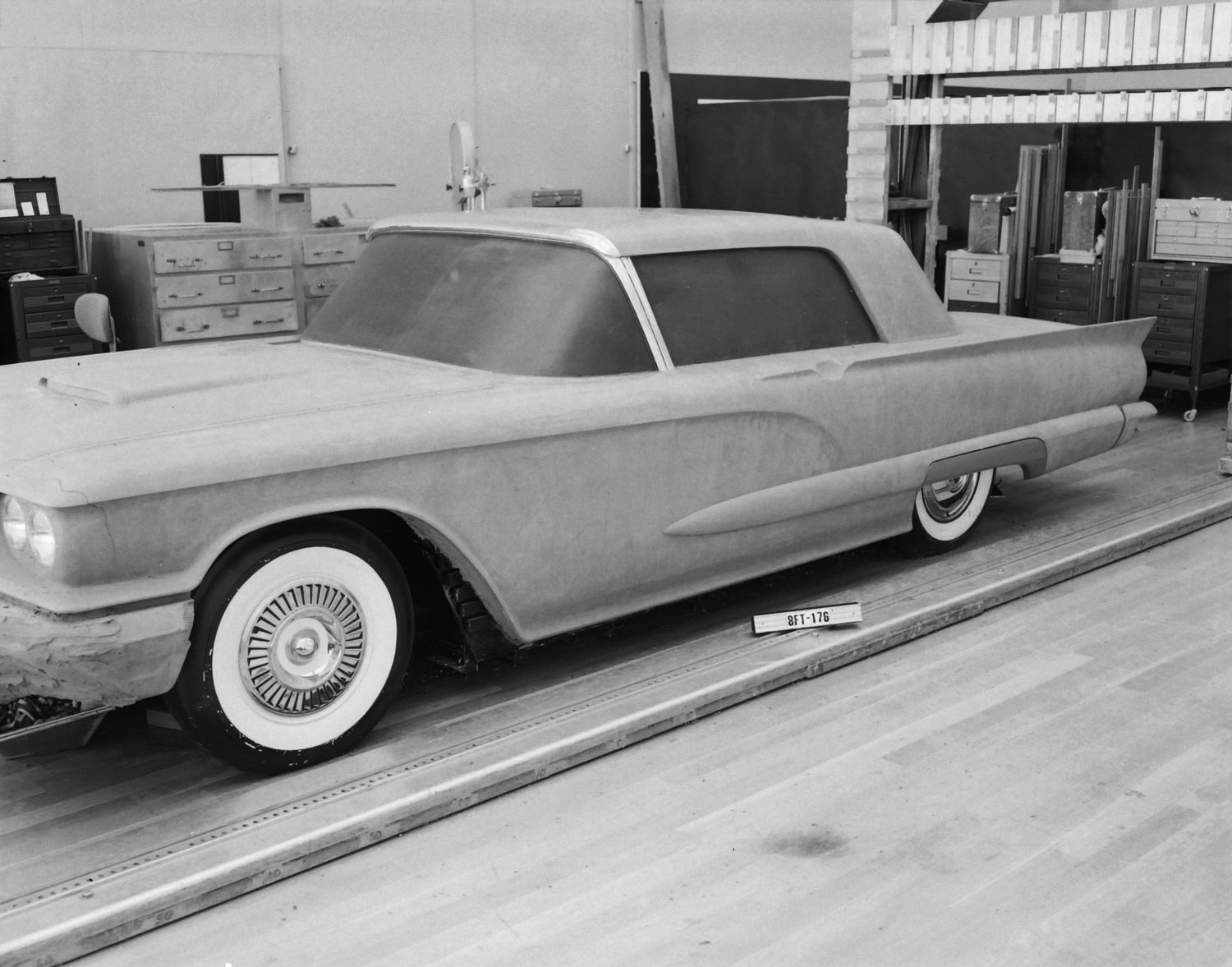
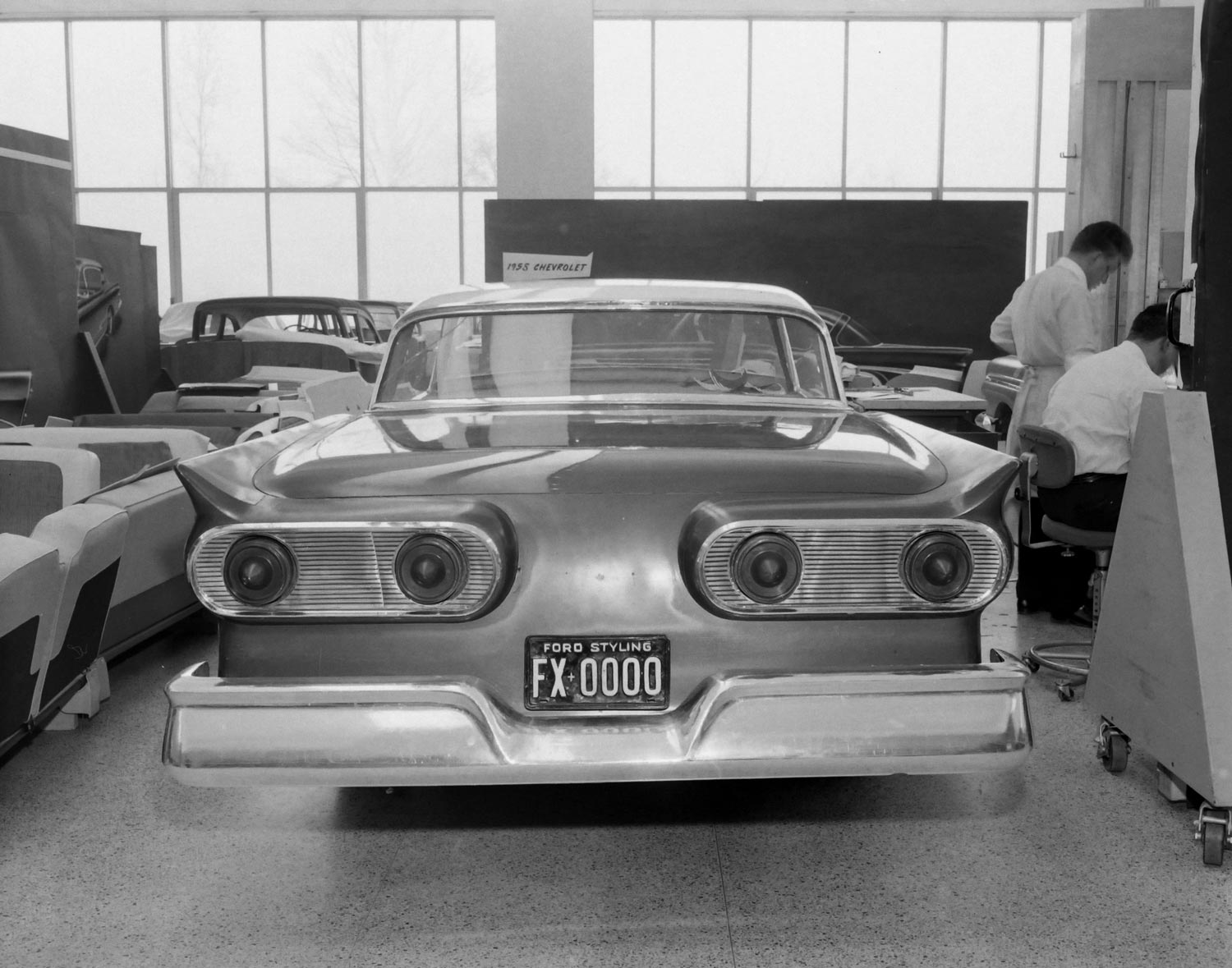
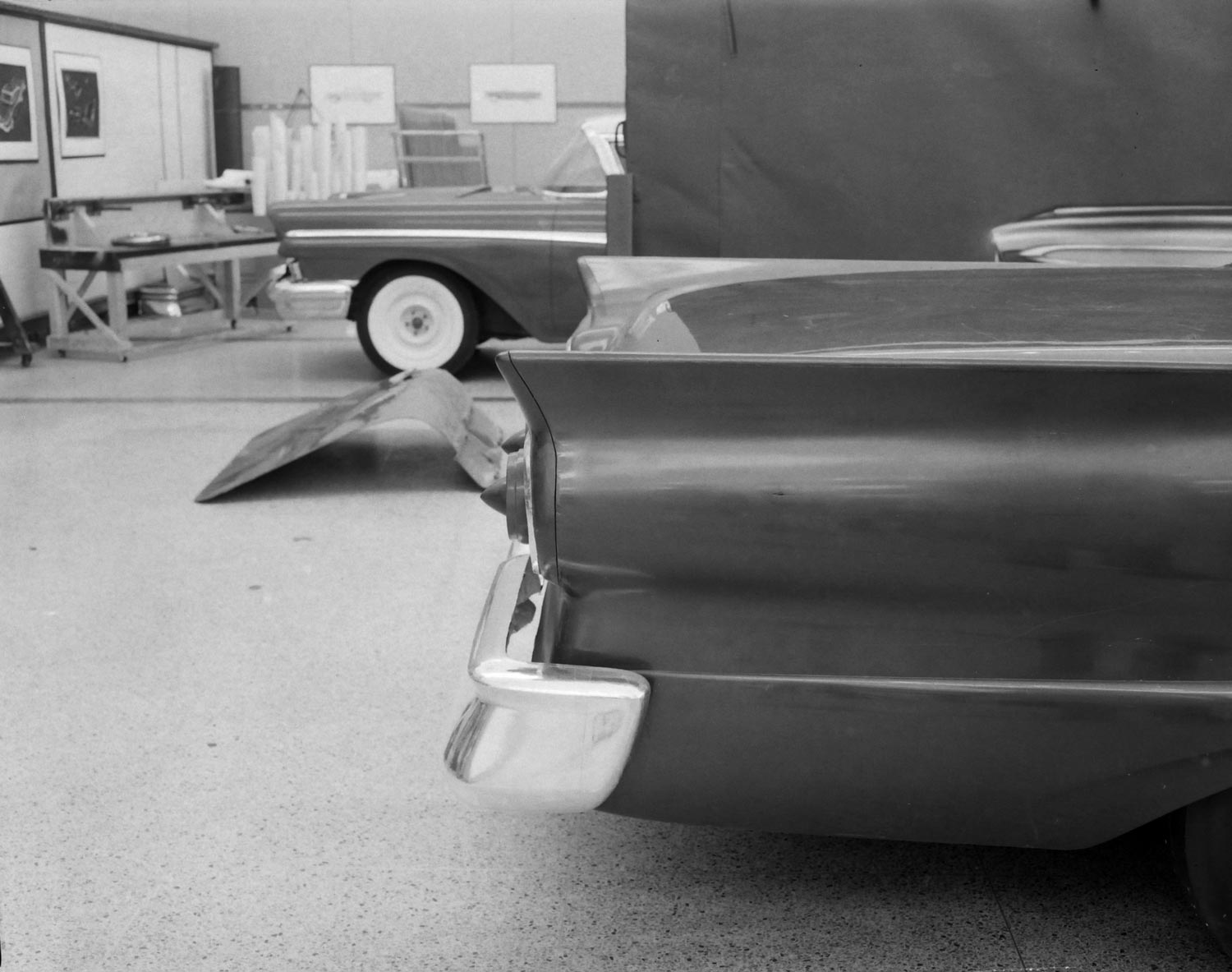
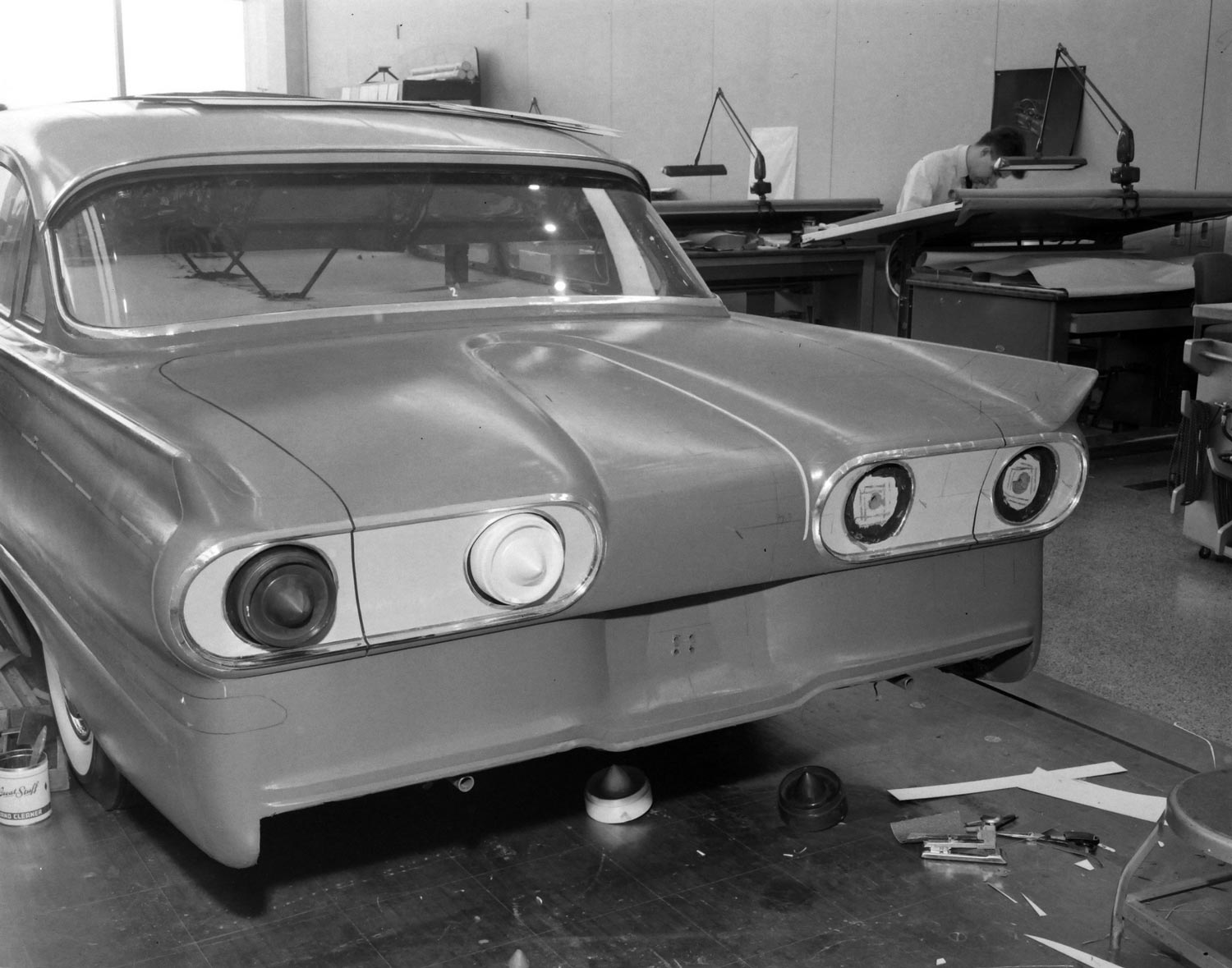
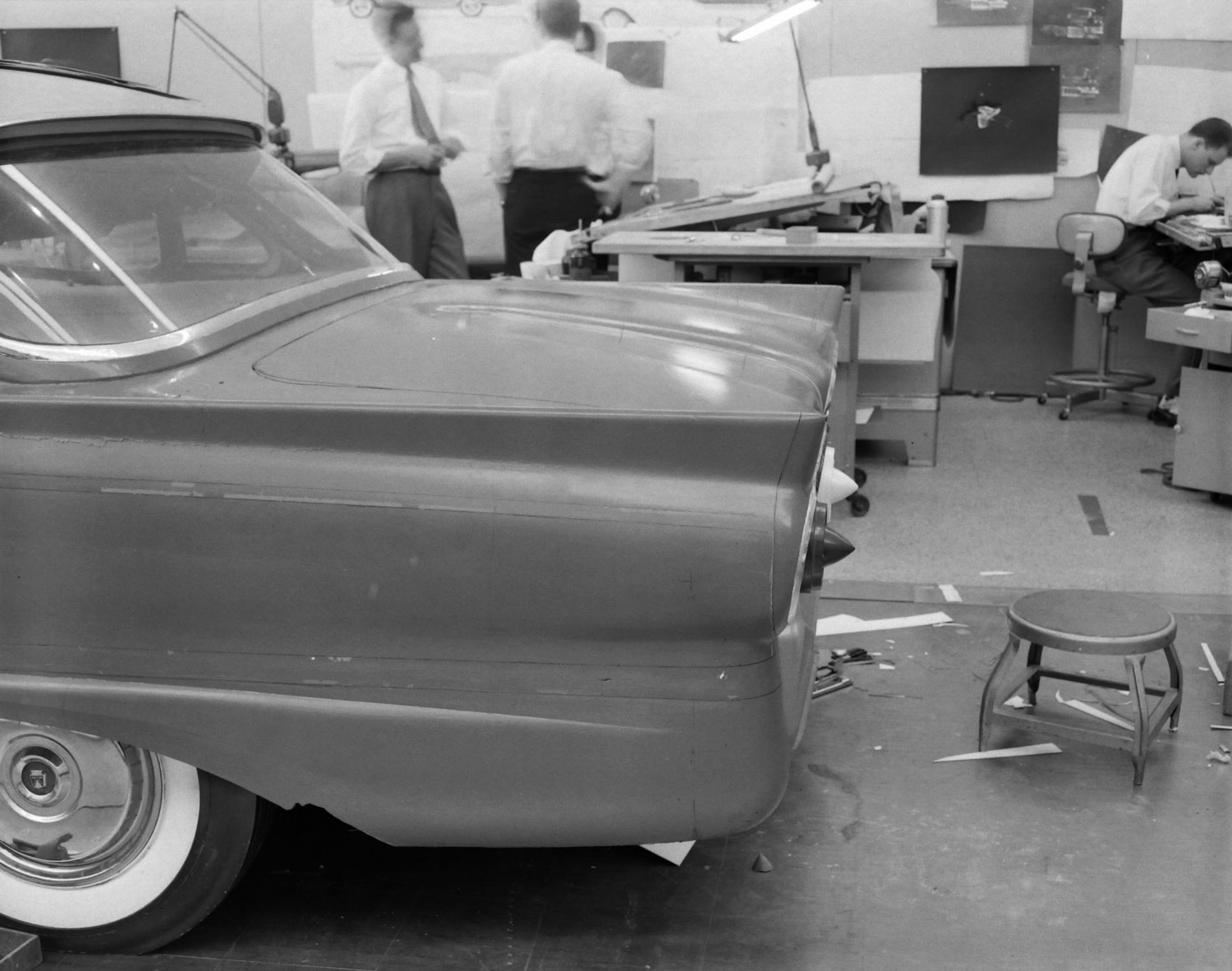
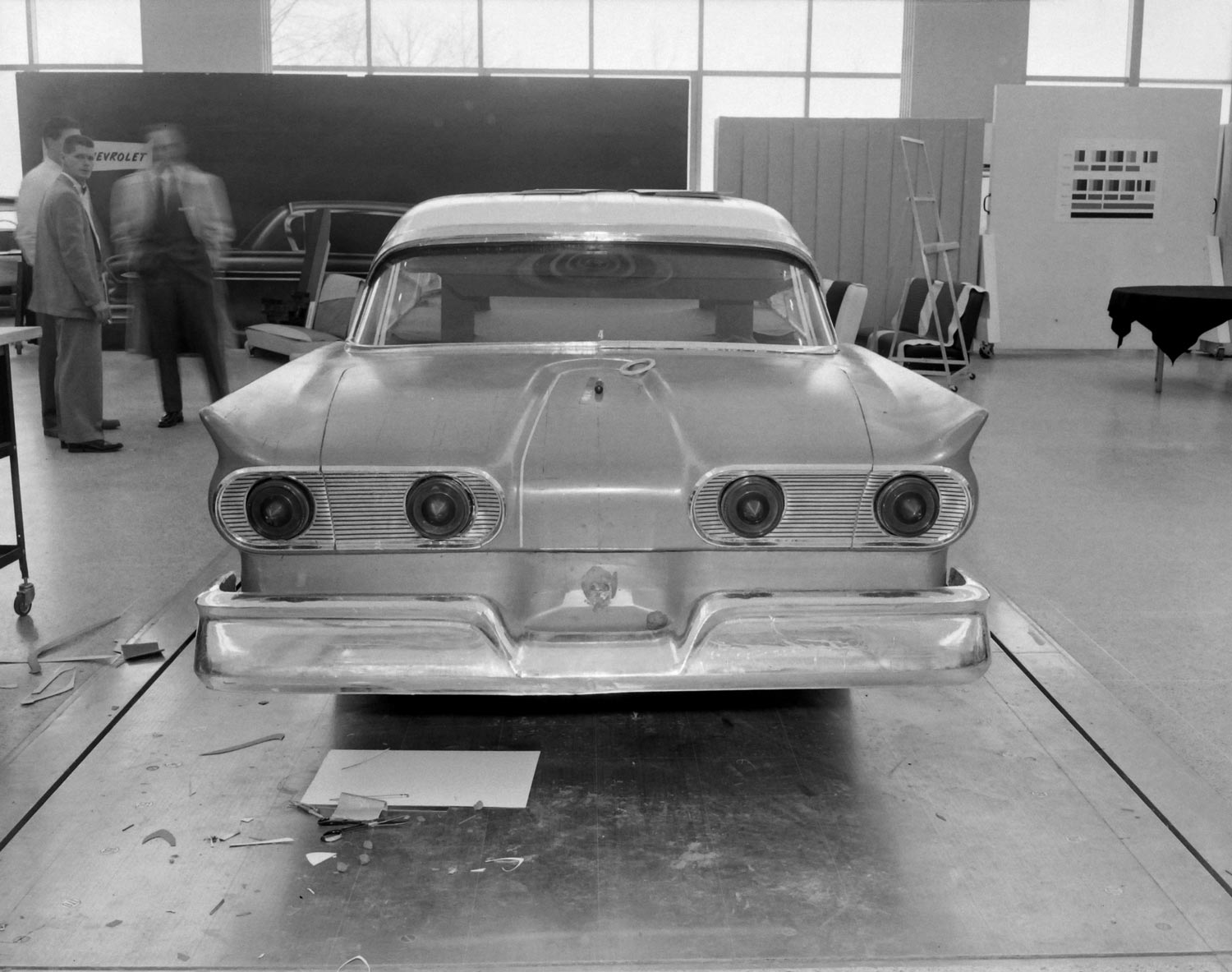
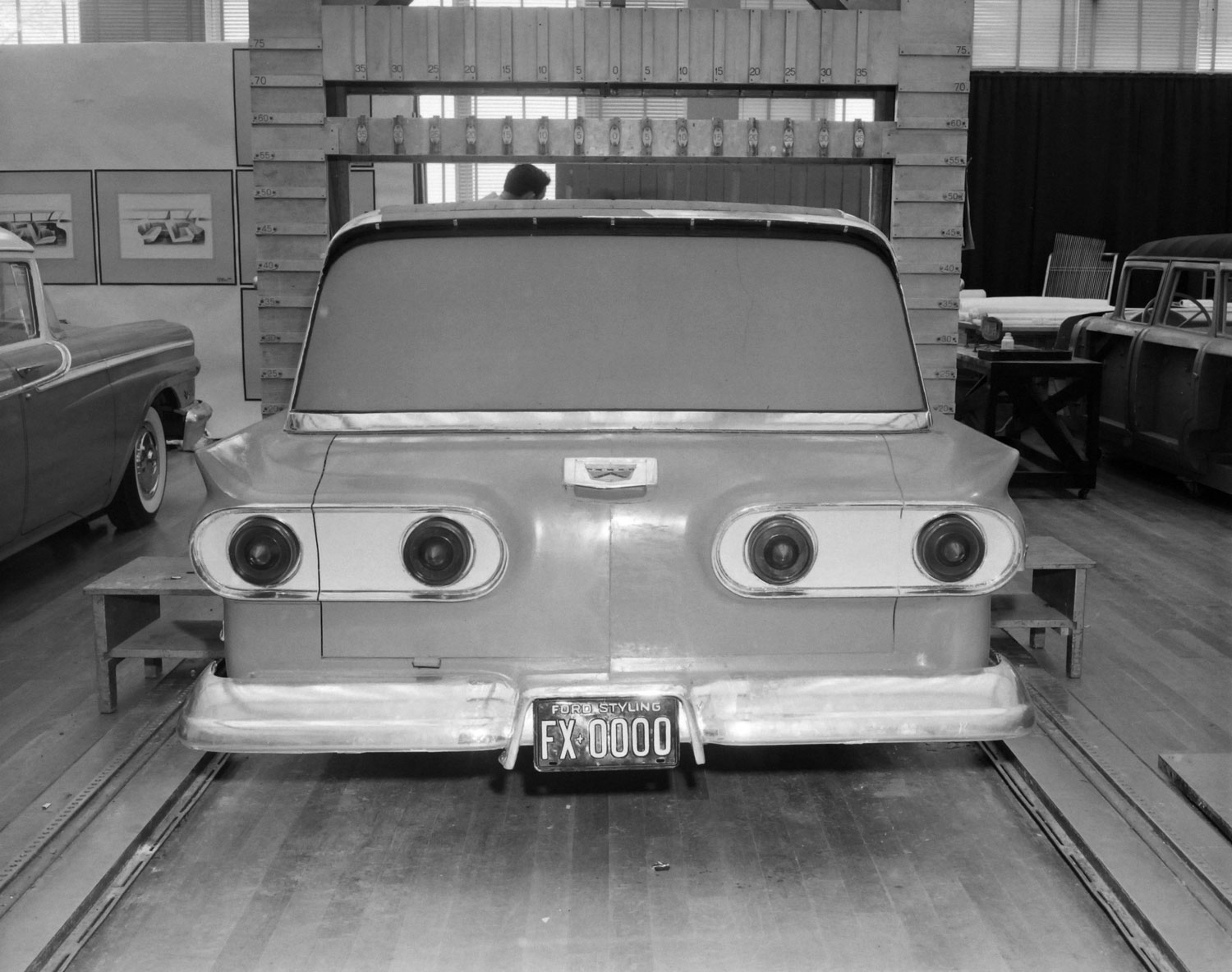
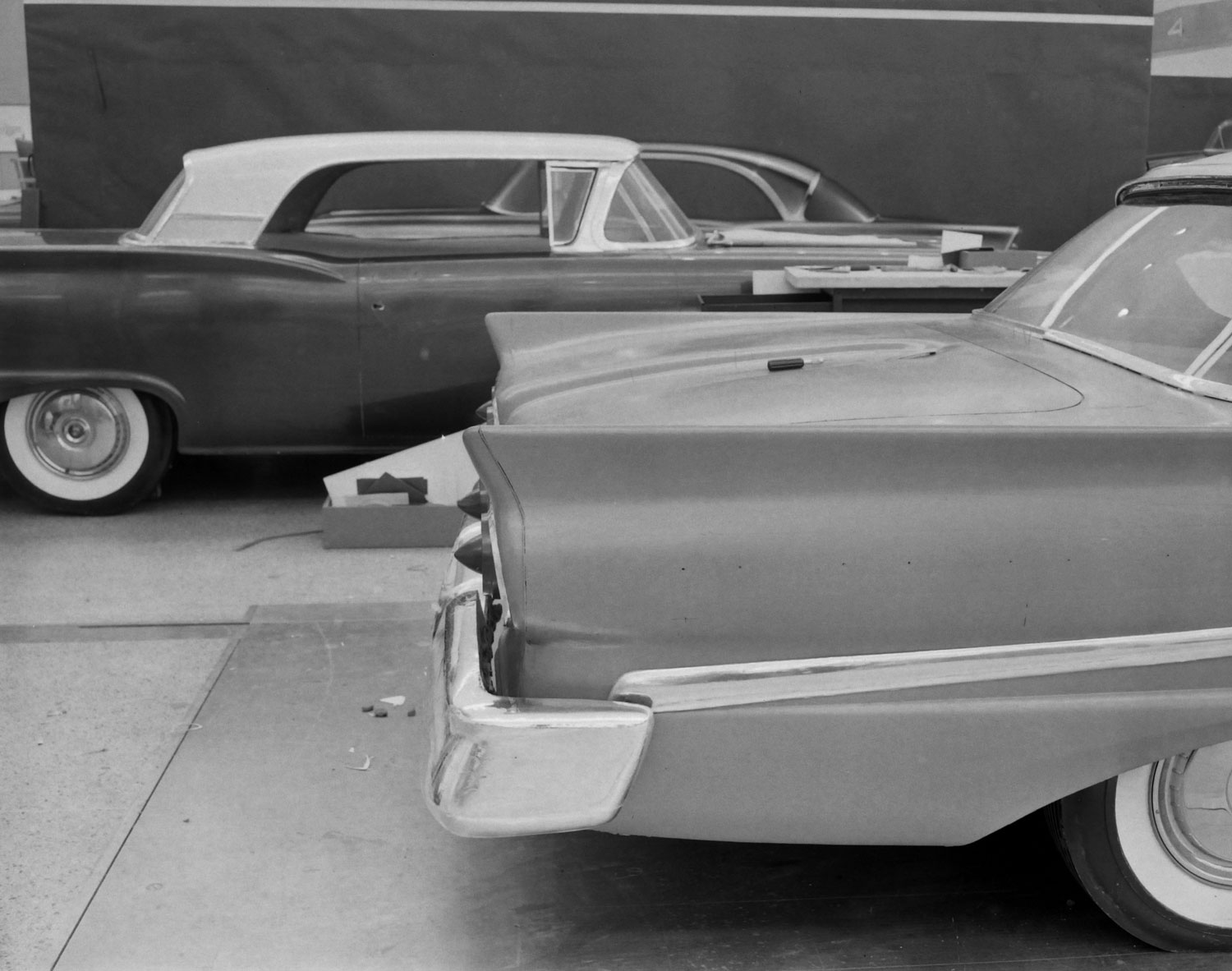
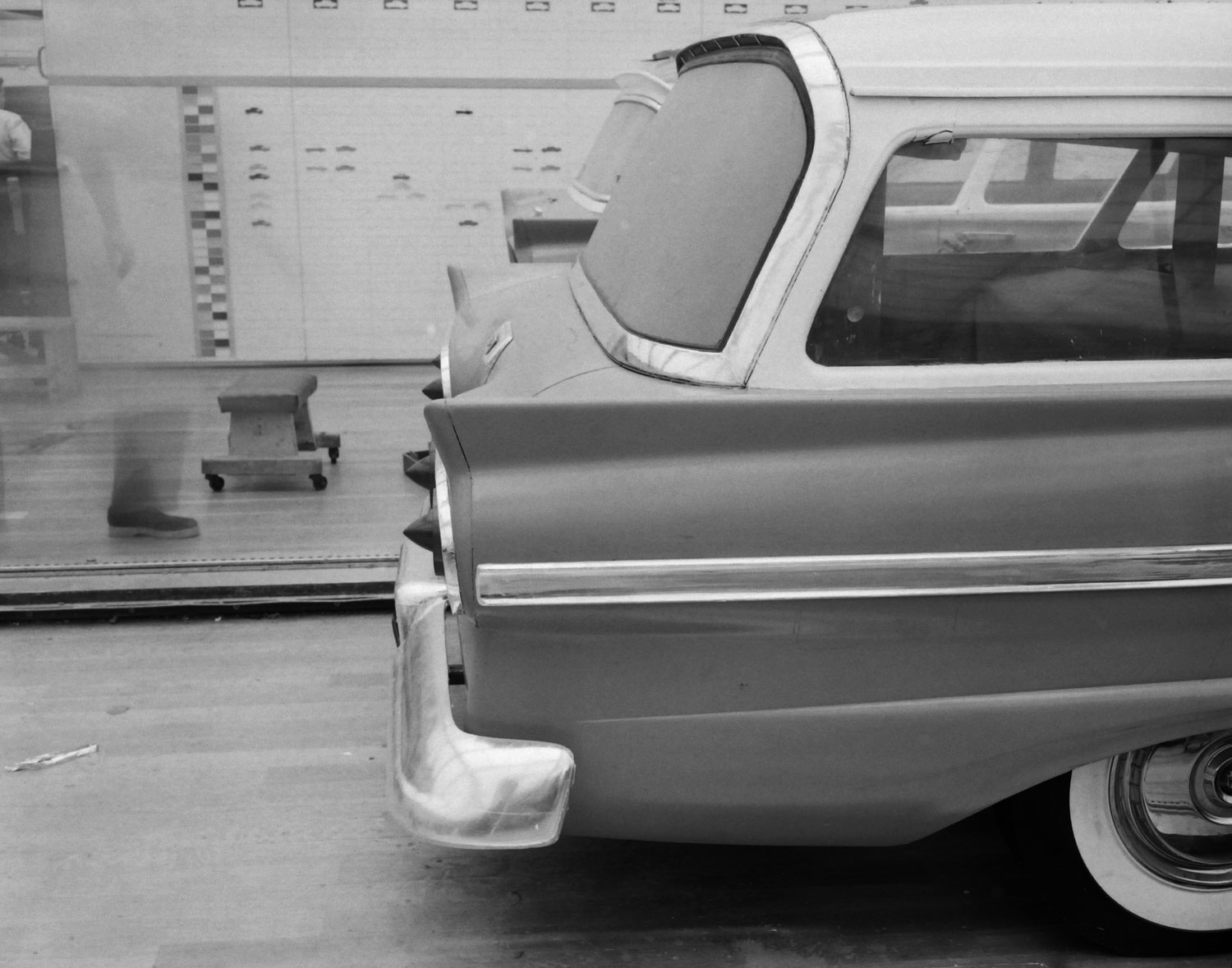
When you micromanage from above, especially a bean counter like Wright, you are going to get some pretty awful styling designs as seen in this report.
The only beautiful thing, here, is the report itself. A perfect telling of a trying time at Ford Design Center. Joe Oros must have had a tough time restraining himself.
After looking at the alternatives , I’d say ’57 was the zenith for what could be done with that body shell. Is it implied that the Edsel project (and Lincoln and Thunderbird) depleted the capital needed to redesign and retool Ford? Or was it just that McNamara was a skinflint?
I have always felt that the problem with the 1958 Ford was not the rear-end treatment, but the front end. The front headlights were not so much the problem but how the grill and bumper treatment were integrated below the headlights. The elegant 1957 grill / bumper styling were made bulbous in 1958. The 1958 Ford, with a two-year-old body, looked dated.
The 57 was sleek. The 58 looked fat.
It is interesting to note that Ford outsold Chevrolet in 1957 but in the years since then the ’57 Chevy has become an American Icon…..and the ’57 Ford is just a car. And not a particularly well-remembered one, either. Even the ’57 Thunderbird, which I personally prefer, doesn’t have the cachet of its earlier brethren. From my consumer viewpoint it looks often like Ford is thrashing to do whatever it can to defeat GM and seldom accomplishing much while doing so. One simple example: Chevrolet brings out an overhead-valve V8 engine in the early 50’s. They proceed to continue to produce variants of that engine to this day. Now look at how many engines Ford has produced and dropped over that same time, much less that the small-block Chevrolet V8 is the most successful race car engine in history. Where’s Ford in that story?
Amazing nobody, even GM designers, much understands or cares how Ford Motor Co. entirely copied and or pirated the Harley Earl operating system along with GM technology spotlighted in all these historical photos at Ford. None of the full-size clay models here would have been built and there wouldn’t have been a “Design Dept” at Ford if Harley E. had never moved from Hollywood to Motordom to disrupt the transportation industry and become GM’s initial head of design at GM in the 1920s.
Not joking, Ford would have never build all their iconic modern cars, like the Thunderbird and even the Mustang without Harley J. E’s design department to be there and show Ford the way. Harley knew all this but had his reasons for not talking about it.
Oddly, Ford seemed totally unaware of what Exner was doing at Chrysler during this phase, but was overly concerned with what Chevrolet was up to, which turned out to be a disappointment if not an outright failure as a one-year-only design. I thought the ’57 Ford was OK at best – the headlight treatment never wowed me, though the rear treatment was good – but the ’58 did absolutely nothing for me. In these renderings the various taillight treatments all looked better than what made production, while the production ’58 front end looked both cheap and ungainly.
Ford seemed often to have organizational strife which usually resulted in products being less than what they could have been, though sometimes they hit a home run.
After reading much of the Lincoln book it has become clear to me that GM had a big advantage in Harley Earl who as it turned out was a design talent as well as a strategic wizard. His process development skills resulted in consistant design direction for GM for many years. He also hired dynamic people in the place of the weaker ones that he fired.
Ford Styling had great talent but was frought with political dissension, I think the Ford family had to be part of that. The turmoil at Ford Styling had a clear impact on the resultant design result of Ford Products. Too many misses.
Edsel’s designs, including the Fordson Tractor were some of the best ever done at Ford. That was followed by the Lincoln four door convertible that has never been equaled. The Mustang has been a star through the years with a few hiccups. LIncoln has not had an outstanding concept car since.
The Lincoln Chief Designer invited me to see “Something New”, that is the 1992 Lincoln Continental first being shown at the NAIAS. This he said is really new, not like the 1992 Cadillac Eldorado that I was responsible for that was also being previewed. Twelve years later the Eldorado finally stopped production as the Hamtramck plant had some new work. At that point no-one could even remember what rhe Lincoln looked like yet people were still buying Eldorados.
The Lincoln book shows the many designers, chief designers and design VP’s involved in Lincoln history, way too many. This is the opposite of GM Styling under Harley Earl who brought consistant and strong design direction, organizational and process expansion, stability and a very high standard for many years.
He was feared and admired. Bill Mitchell followed Earl, enheriting a great talented and organized staff, excellent design processes that enhanced design development and a facility at the GM Tech Center that is still admired by industry around the world. And Mitchell was really a great, confident and experienced designer.
GM Styling / Design has a unique history that was really shaped by Harley Earl, a brilliant choice by Alfred E. Sloan. Earl learned a lot by hanging around with Sloan and the other GM founders as he also did by his association with his own father and his employer of the time, Cecil B. DeMille.
If Edsel Ford had lived – he died in 1943 – the design direction at Ford would have been far different. Even though he never claimed to be a designer, in every sense of the word Edsel was Ford’s design leader and a better designer than is generally realized. Given his interest in design, if he had lived, Edsel’s design influence would have continued at least until his retirement at age 65, which would have been in 1958. If he lived as long as his father, he could have been involved in Ford design until 1976. Those designers, modelers and design department personnel who worked with him admired and respected him and his design judgement. No one feared him. It has been reported by people who worked with him that Edsel made his design suggestions in such a way that it seemed like the designer or modeler he was talking with had initiated the suggestion himself. He had a special way of working with people that Harley Earl, as talented as he was, never had. Edsel Ford was responsible for the design of production Fords, Mercurys and Lincolns through 1941. It does not detract from Harley Earl to point out that the cars produced at Ford during the Edsel Ford years, at least in our opinion, were cleaner and more attractive than those produced at GM. After Edsel death, Ford and GM both had good and bad years as far as design was concerned, although GM probably produced more design innovations than Ford.
Harley Earl had great design sense, and he was the long-time design leader at GM. If Edsel Ford had lived, he would have equaled or surpassed Earl in product design. If he had lived,Edsel Ford would today be as recognized for his design leadership as Earl now is. Edsel Ford’s death was the biggest tragedy ever suffered by Ford Motor Co., and it effected every aspect of production, especially the design of vehicles, until at least the end of the 20th century.
It appears to us, generally, to have been a mistake to bring in outsiders to lead an automotive design department. Historically but not always, that has been a problem at Ford. Although it is not without disagreement, hiring George Walker as head of Ford’s Styling Center was, in our opinion, probably a mistake. The good he did, such as securing higher salaries for designers, appears to have been outweighed by the divisions he caused among Styling Center personnel. Those divisions included favoring Masons as opposed to Catholics. Many employees also lost respect for Walker because of his on-the-job sexual conquests which were open and well advertised.
William Clay Ford, Edsel’s youngest son, had his father’s design sense and was well liked by those he worked with. He was never allowed to have the influence on design his father had, and after the Mark II was cancelled, he lost interest in Ford and Ford Design. If given the chance, Bill Ford could have done great things for Ford design.
The production designs advocated by Gene Bordiant, Ford’s head of design fi the 1960s and 70s were, as a general rule, successful during the 1960s. After that, his influence appears spotty. Bordinat once described himself as a brown-noser to Henry Ford II, but he lost any clout he had at Ford because of his friendship and his close working relationship with Lee Iacocca, which led to his downfall at Ford.
Jack Telnack, Ford’s design leader during the 1980 and ‘90s, was exactly what you expected a design leader to look and talk like, and his advocacy of European aerodynamics in the 1980s revitalized Ford and established his position as the design leader in the automobile industry.
It would be helpful if there was a book on GM design so those of us who are not designers could make up our own minds whether Ford designs were better than GM or visa versa. We strongly suspect, however, that opinion will always vary among those asked, and maybe from year to year.
Oh, the sheer misplaced optimism of ” help Ford catch and surpass GM sooner than what was already planned and approved at Ford” . I don’t know what was being smoked there, but it was stronger than Winston or Lucky Strike.
Interesting and entertaining article, thank you.
Why is that man pointing at some part of the car in so many pictures? It’s too much to believe all the pictures happen to catch him pointing to someone at the time.
I wondered the same thing.—Gary
There is a lot of piling on of the 1958 Ford in these posts, but if you compare it to its ‘58 competitors from GM, the ‘58 Fairlane is lean and sleek when viewed next to the over wrought, atrociously ornamented ‘58 Impalas, Oldsmobiles and especially Buicks. Everything is a product of its time, and the ’58 Fairlane looks better when viewed next to the excesses of its era.
The 1957 Ford Fairlane 500 that was managed in design by Joe Oros and other designers at the Ford Design Center hit the mark as the car style that the public wanted and bought (notably outselling competitors). The body style had the ‘big car look’ but was built on an affordable budget for the American driving public. The car look (impressive from every angle) based upon features of a ‘space age’ look with those sleek panels ending in ‘jet pod taillights.’ The frame and chassis allowed for a lower CG and as a result better handling as well as the new 14” wheels. Performance options that included dual quads and super-charged engines dominated the race track. Had the management followed thru with this 1957 model and not diluted with other ‘irons-in-the-fire’ ie., excessive expenditure in creating other designs that went no where—I’m sure Ford’s bottom-line would have been much better.
In keeping what I believe is true—I bought and kept several convertible Sunliner 1957 Fords (one of which happens to be a signature ‘57 Skyliner car by Ben Smith as I met him at a Skyliner gathering shortly before his passing. A true gentleman that worked on the ‘retractable design’ at Ford Motor Company and drove a 1957 black Fairlane 500 Skyliner similar to mine.
I won’t every forget that ‘feel of the road and enthusiasm’ with those new 1957 Fords’ since I was 16 years of age.
Gene
I really enjoyed reading the above posts. I think I may be a little younger than these guys, but I the late 60s I read all about what was going on with the Big Three. I was born in Detroit, my dad’s side of the family were all at Ford and had been since the beginning. My mom’s side was at Chrysler, so you can imagine what our Sunday dinners were like.
My family moved to Southern California in June of 1958, and left the auto industry back in Detroit and never looked back. I guess it was because how hard it was when the UAW was seeping into the industry. My dad worked very closely with Henry Ford and resisted the union as long as possible. I know had my parents stayed in Detroit I too would have worked at Ford.
I have only driven vehicles from The Ford Motor Company. I do have an attraction to some Chrysler vehicles, but unfortunately Chrysler never really had the money to spend that GM and Ford did and does. It might be because it’s in my blood but I seem to only be comfortable with Fords. I really like their style that shows in all their brands. Their engines and drive trains are tough and seem to love being driven.
I can’t say I agree with everything Ford does, and it may be the family influence that I like, my own family involvement connects me too. It’s hard to know when building cars or other iconic products for the mass public if you’re giving the public what they want.
My career was with IBM. IBM built the world wide information technology business by providing clients with products they didn’t even know they wanted or needed. Back in the day, Detroit did the same thing. In the ’70s that all changed. The Big Three no longer owned 75% of the global automotive market anymore, and they never will again. The same thing happened to IBM in the ’90s when mainframe computers were replaced with file servers, but IBM stuck it out, they continued to sell mainframes, but a modified version of them. Who knows what would have happened to the US auto industry had it not been for the oil crisis of 1973, and we never will.
To me there in lies the problem. The crisis forced the US market to care about gas mileage, we never did before, we never had to. It took Detroit years to change it’s course. The American auto industry built the cars American drivers wanted, and they didn’t care about gas mileage for Pete’s Sake. It kills me to see all the foreign cars on our American roads, but America is a much different place today. There’s no loyalty to American brands because the people in America today are a lot different than in the past. It all changed with that ’73 oil crisis and unless you were here back then, you probably don’t have any idea what I’m talking about. The take away is things are constantly changing. History doesn’t really matter, even though History is how we got here.
I really enjoyed reading the above posts. I think I may be a little younger than these guys, but I the late 60s I read all about what was going on with the Big Three. I was born in Detroit, my dad’s side of the family were all at Ford and had been since the beginning. My mom’s side was at Chrysler, so you can imagine what our Sunday dinners were like. My family moved to Southern California in June of 1958, and left the auto industry back in Detroit and never looked back. I guess it was because how hard it was when the UAW was seeping into the industry. My dad worked very closely with Henry Ford and resisted the union as long as possible. I know had my parents stayed in Detroit I too would have worked at Ford. I have only driven vehicles from The Ford Motor Company. I do have an attraction to some Chrysler vehicles, but unfortunately Chrysler never really had the money to spend that GM and Ford did and does. It might be because it’s in my blood but I seem to only be comfortable with Ford’s. I really like their style that shows in all their brands. Their engines and drive trains are tough and seem to love being driven. I can’t say I agree with everything Ford does, and it may be the family influence that I like, my own family involvement connects me too. It’s hard to know when building cars or other iconic products for the mass public if you’re giving the public what they want. My career was with IBM. IBM built the world wide information technology business by providing clients with products they didn’t even know they wanted or needed. Back in the day, Detroit did the same thing. In the 70s that all changed. The Big Three no longer owned 75% of the global automotive market anymore, and they never will again. The same thing happened to IBM in the 90s when mainframe computers were replaced with file servers, but IBM stuck it out, they continued to sell mainframes, but a modified version of them. Who knows what would have happened to the US auto industry had it not been for the oil crisis of 1973, and we never will. To me there in lies the problem. The crisis forced the US market to care about gas mileage, we never did before, we never had to. It took Detroit years to change it’s course. The American auto industry built the cars American drivers wanted, and they didn’t care about gas mileage for Pete’s Sake. It kills me to see all the foreign cars on our American roads, but America is a much different place today. There’s no loyalty to American brands because the people in America today are a lot different than in the past. It all changed with that 73 oil crisis and unless you were here back then, you probably don’t have any idea what I’m talking about. The take away is things are constantly changing. History doesn’t really matter, even though History is how we got here.